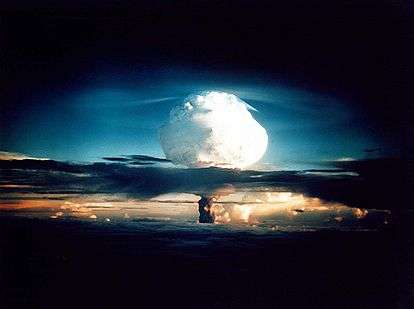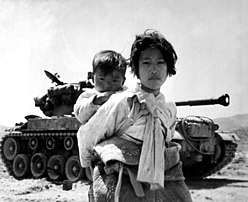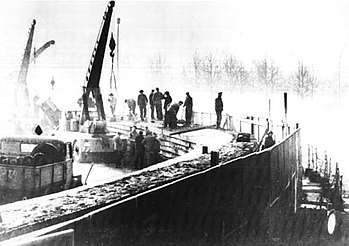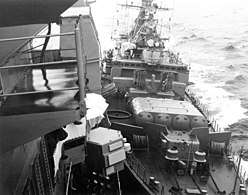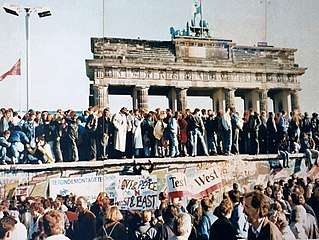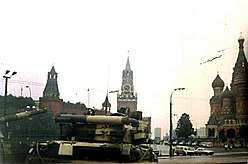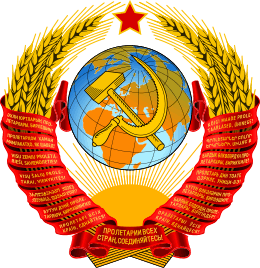Cold War
The Cold War was a period of geopolitical tension between the Soviet Union and the United States and their respective allies, the Eastern Bloc and the Western Bloc, after World War II. The period is generally considered to span the 1947 Truman Doctrine to the 1991 dissolution of the Soviet Union. The term "cold" is used because there was no large-scale fighting directly between the two superpowers, but they each supported major regional conflicts known as proxy wars. The conflict was based around the ideological and geopolitical struggle for global influence by the two powers, following their temporary alliance and victory against Nazi Germany in 1945.[1] The doctrine of mutually assured destruction (MAD) discouraged a pre-emptive attack by either side. Aside from the nuclear arsenal development and conventional military deployment, the struggle for dominance was expressed via indirect means such as psychological warfare, propaganda campaigns, espionage, far-reaching embargoes, rivalry at sports events and technological competitions such as the Space Race.
(1947–1991)
the August Coup, 1991
The West was led by the United States as well as the other First World nations of the Western Bloc that were generally liberal democratic but tied to a network of authoritarian states, most of which were their former colonies.[2][upper-alpha 1] The East was led by the Soviet Union and its Communist Party, which had an influence across the Second World. The US government supported right-wing governments and uprisings across the world, while the Soviet government funded communist parties and revolutions around the world. As nearly all the colonial states achieved independence in the period 1945–1960, they became Third World battlefields in the Cold War.
The first phase of the Cold War began immediately after the end of the Second World War in 1945. The United States created the NATO military alliance in 1949 in the apprehension of a Soviet attack and termed their global policy against Soviet influence containment. The Soviet Union formed the Warsaw Pact in 1955 in response to NATO. Major crises of this phase included the 1948–49 Berlin Blockade, the 1927–50 Chinese Civil War, the 1950–53 Korean War, the 1956 Suez Crisis, the Berlin Crisis of 1961 and the 1962 Cuban Missile Crisis. The USSR and the US competed for influence in Latin America, the Middle East, and the decolonizing states of Africa and Asia.
Following the Cuban Missile Crisis, a new phase began that saw the Sino-Soviet split between China and the Soviet Union complicate relations within the Communist sphere, while US ally France began to demand greater autonomy of action. The USSR invaded Czechoslovakia to suppress the 1968 Prague Spring, while the US experienced internal turmoil from the civil rights movement and opposition to the Vietnam War. In the 1960s–70s, an international peace movement took root among citizens around the world. Movements against nuclear arms testing and for nuclear disarmament took place, with large anti-war protests. By the 1970s, both sides had started making allowances for peace and security, ushering in a period of détente that saw the Strategic Arms Limitation Talks and the US opening relations with the People's Republic of China as a strategic counterweight to the USSR.
Détente collapsed at the end of the decade with the beginning of the Soviet–Afghan War in 1979. The early 1980s were another period of elevated tension. The United States increased diplomatic, military, and economic pressures on the Soviet Union, at a time when it was already suffering from economic stagnation. In the mid-1980s, the new Soviet leader Mikhail Gorbachev introduced the liberalizing reforms of glasnost ("openness", c. 1985) and perestroika ("reorganization", 1987) and ended Soviet involvement in Afghanistan. Pressures for national sovereignty grew stronger in Eastern Europe, and Gorbachev refused to militarily support their governments any longer. The result in 1989 was a wave of revolutions that (with the exception of Romania) peacefully overthrew all of the communist governments of Central and Eastern Europe. The Communist Party of the Soviet Union itself lost control in the Soviet Union and was banned following an abortive coup attempt in August 1991. This in turn led to the formal dissolution of the USSR in December 1991, the declaration of independence of its constituent republics and the collapse of communist governments across much of Africa and Asia. The United States was left as the world's only superpower.
The Cold War and its events have left a significant legacy. It is often referred to in popular culture, especially with themes of espionage and the threat of nuclear warfare. Meanwhile, a renewed state of tension between the Soviet Union's successor state, Russia, and the United States in the 21st century (including its Western allies) as well as growing tension between an increasingly powerful China and the U.S. and its Western allies have each been referred to as the Second Cold War.[3]
Origins of the term
At the end of World War II, English writer George Orwell used cold war, as a general term, in his essay "You and the Atomic Bomb", published 19 October 1945 in the British newspaper Tribune. Contemplating a world living in the shadow of the threat of nuclear warfare, Orwell looked at James Burnham's predictions of a polarized world, writing:
Looking at the world as a whole, the drift for many decades has been not towards anarchy but towards the reimposition of slavery... James Burnham's theory has been much discussed, but few people have yet considered its ideological implications—that is, the kind of world-view, the kind of beliefs, and the social structure that would probably prevail in a state which was at once unconquerable and in a permanent state of "cold war" with its neighbours.[4]
In The Observer of 10 March 1946, Orwell wrote, "after the Moscow conference last December, Russia began to make a 'cold war' on Britain and the British Empire."[5]
The first use of the term to describe the specific post-war geopolitical confrontation between the Soviet Union and the United States came in a speech by Bernard Baruch, an influential advisor to Democratic presidents,[6] on 16 April 1947. The speech, written by a journalist Herbert Bayard Swope,[7] proclaimed, "Let us not be deceived: we are today in the midst of a cold war."[8] Newspaper columnist Walter Lippmann gave the term wide currency with his book The Cold War. When asked in 1947 about the source of the term, Lippmann traced it to a French term from the 1930s, la guerre froide.[upper-alpha 2]
Background
Russian Revolution
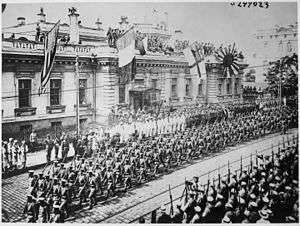
While most historians trace the origins of the Cold War to the period immediately following World War II, others argue that it began with the October Revolution in Russia in 1917 when the Bolsheviks took power. In World War I, the British, French and Russian Empires had comprised the Allied Powers from the start, and the U.S. joined them in April 1917. The Bolsheviks seized power in Russia in November 1917 and fulfilled their promise to withdraw from WWI, and German armies advanced rapidly across the borderlands. The Allies responded with an economic blockade against all of Russia.[9] In early March 1918, the Soviets followed through on the wave of popular disgust against the war and accepted harsh German peace terms with the Treaty of Brest-Litovsk. In the eyes of some Allies, Russia now was helping Germany to win the war by freeing up a million German soldiers for the Western Front[10] and by
"relinquishing much of Russia's food supply, industrial base, fuel supplies, and communications with Western Europe."[11][12]
According to historian Spencer Tucker, the Allies felt, "The treaty was the ultimate betrayal of the Allied cause and sowed the seeds for the Cold War. With Brest-Litovsk the spectre of German domination in Eastern Europe threatened to become reality, and the Allies now began to think seriously about military intervention," and proceeded to step up their "economic warfare" against the Bolsheviks.[9] Some Bolsheviks saw Russia as only the first step, planning to incite revolutions against capitalism in every western country, but the need for peace with Germany led Soviet leader Vladimir Lenin away from this position.[upper-alpha 3]
In 1918 Britain provided money and troops to support the anti-Bolshevik "White" counter-revolutionaries. This policy was spearheaded by Minister of War Winston Churchill, a committed British imperialist and anti-communist.[13] France, Japan and the United States invaded Russia in an attempt to topple the new Soviet government. Despite the economic and military warfare launched against it by Western powers, the Bolshevik government succeeded in defeating all opposition and took full control of Russia, as well as breakaway provinces such as Ukraine, Georgia, Armenia, and Azerbaijan.[14]
Western powers also diplomatically isolated the Soviet government. Vladimir Lenin stated that the Soviet Union was surrounded by a "hostile capitalist encirclement" and he viewed diplomacy as a weapon to keep Soviet enemies divided.[15] He set up an organization to promote sister revolutions worldwide, the Comintern. It failed everywhere; it was crushed when it tried to start revolutions in Germany, Bavaria, and Hungary.[16] The failures led to an inward turn by Moscow.
Britain and other Western powers—except the United States—did business and sometimes recognized the new Soviet Union. By 1933, old fears of Communist threats had faded, and the American business community, as well as newspaper editors, were calling for diplomatic recognition. President Franklin D. Roosevelt used presidential authority to normalize relations in November 1933.[17] However, there was no progress on the Tsarist debts Washington wanted Moscow to repay. Expectations of expanded trade proved unrealistic. Historians Justus D. Doenecke and Mark A. Stoler note that, "Both nations were soon disillusioned by the accord."[18] Roosevelt named William Bullitt as ambassador from 1933 to 1936. Bullitt arrived in Moscow with high hopes for Soviet–American relations, but his view of the Soviet leadership soured on closer inspection. By the end of his tenure, Bullitt was openly hostile to the Soviet government, and he remained an outspoken anti-communist for the rest of his life.[19]
Beginnings of World War II
In the late 1930s, Stalin had worked with Foreign Minister Maxim Litvinov to promote popular fronts with capitalist parties and governments to oppose fascism. The Soviets were embittered when Western governments chose to practice appeasement with Nazi Germany instead. In March 1939 Britain and France—without consulting the USSR—granted Hitler control of much of Czechoslovakia at the Munich Agreement. Facing an aggressive Japan at Soviet borders as well, Stalin changed directions and replaced Litvinov with Vyacheslav Molotov, who negotiated closer relations with Germany.[20]
After signing the Molotov–Ribbentrop Pact and German–Soviet Frontier Treaty, the Soviet Union forced the Baltic countries—Estonia, Latvia, and Lithuania—to allow it to station Soviet troops in their countries.[21] Finland rejected territorial demands, prompting a Soviet invasion in November 1939. The resulting Winter War ended in March 1940 with Finnish concessions.[22] Britain and France, treating the Soviet attack on Finland as tantamount to its entering the war on the side of the Germans, responded to the Soviet invasion by supporting the USSR's expulsion from the League of Nations.[23]
In June 1940, the Soviet Union forcibly annexed Estonia, Latvia, and Lithuania.[24] It also seized the disputed Romanian regions of Bessarabia, Northern Bukovina, and Hertza. But after the German Army invaded the Soviet Union in Operation Barbarossa in June 1941 and declared war on the United States in December 1941, the Soviet Union and the Allied powers worked together to fight Germany. Britain signed a formal alliance and the United States made an informal agreement. In wartime, the United States supplied Britain, the Soviet Union and other Allied nations through its Lend-Lease Program.[25] However, Stalin remained highly suspicious, and he believed that the British and the Americans had conspired to ensure that the Soviets bore the brunt of the fighting against Germany. According to this view, the Western Allies had deliberately delayed opening a second anti-German front in order to step in at the last minute and shape the peace settlement. Thus, Soviet perceptions of the West left a strong undercurrent of tension and hostility between the Allied powers.[26]
End of World War II (1945–1947)
Wartime conferences regarding post-war Europe
The Allies disagreed about how the European map should look, and how borders would be drawn, following the war.[27] Each side held dissimilar ideas regarding the establishment and maintenance of post-war security.[27] Some scholars contend that all the Western Allies desired a security system in which democratic governments were established as widely as possible, permitting countries to peacefully resolve differences through international organizations.[28] Others note that the Atlantic powers were divided in their vision of the new post-war world. Roosevelt's goals—military victory in both Europe and Asia, the achievement of global American economic supremacy over the British Empire, and the creation of a world peace organization—were more global than Churchill's, which were mainly centered on securing control over the Mediterranean, ensuring the survival of the British Empire, and the independence of Central and Eastern European countries as a buffer between the Soviets and the United Kingdom.[29]
_(B%26W).jpg)
The Soviet Union sought to dominate the internal affairs of countries in its border regions.[27][30] During the war, Stalin had created special training centers for communists from different countries so that they could set up secret police forces loyal to Moscow as soon as the Red Army took control. Soviet agents took control of the media, especially radio; they quickly harassed and then banned all independent civic institutions, from youth groups to schools, churches and rival political parties.[upper-alpha 4] Stalin also sought continued peace with Britain and the United States, hoping to focus on internal reconstruction and economic growth.[31]
In the American view, Stalin seemed a potential ally in accomplishing their goals, whereas in the British approach Stalin appeared as the greatest threat to the fulfillment of their agenda. With the Soviets already occupying most of Central and Eastern Europe, Stalin was at an advantage, and the two western leaders vied for his favors.
The differences between Roosevelt and Churchill led to several separate deals with the Soviets. In October 1944, Churchill traveled to Moscow and proposed the "percentages agreement" to divide Europe into respective spheres of influence, including giving Stalin predominance over Romania, Hungary, and Bulgaria and Churchill carte blanche over Greece. This proposal was accepted by Stalin. At the Yalta Conference of February 1945, Roosevelt signed a separate deal with Stalin regarding Asia and refused to support Churchill on the issues of Poland and Reparations.[29] Roosevelt ultimately approved the percentage agreement,[32][33] but there was still apparently no firm consensus on the framework for a post-war settlement in Europe.[34]

At the Second Quebec Conference, a high-level military conference held in Quebec City, 12–16 September 1944, Churchill and Roosevelt reached agreement on a number of matters, including a plan for Germany based on Henry Morgenthau Jr.'s original proposal. The memorandum drafted by Churchill provided for "eliminating the warmaking industries in the Ruhr and the Saar ... looking forward to converting Germany into a country primarily agricultural and pastoral in its character." However, it no longer included a plan to partition the country into several independent states.[upper-alpha 5] On 10 May 1945, President Truman signed the US occupation directive JCS 1067, which was in effect for over two years, and was enthusiastically supported by Stalin. It directed the US forces of occupation to "...take no steps looking toward the economic rehabilitation of Germany".[35]
Some historians have argued that the Cold War began when the US negotiated a separate peace with Nazi SS General Karl Wolff in northern Italy. The Soviet Union was not allowed to participate and the dispute led to heated correspondence between Franklin Roosevelt and Stalin. Wolff, a war criminal, appears to have been guaranteed immunity at the Nuremberg trials by Office of Strategic Services (OSS) commander and future CIA director Allen Dulles when they met in March 1945. Wolff and his forces were being considered to help implement Operation Unthinkable, a secret plan to invade the Soviet Union which Winston Churchill advocated during this period.[36][37][38]
In April 1945, President Roosevelt died and was succeeded by Harry S. Truman, who distrusted Stalin and turned for advice to an elite group of foreign policy intellectuals. Both Churchill and Truman opposed, among other things, the Soviets' decision to prop up the Lublin government, the Soviet-controlled rival to the Polish government-in-exile in London, whose relations with the Soviets had been severed.[39]
Following the Allies' May 1945 victory, the Soviets effectively occupied Central and Eastern Europe,[34] while strong US and Western allied forces remained in Western Europe. In Germany and Austria, France, Britain, the Soviet Union and the United States established zones of occupation and a loose framework for parceled four-power control.[40]
The 1945 Allied conference in San Francisco established the multi-national United Nations (UN) for the maintenance of world peace, but the enforcement capacity of its Security Council was effectively paralyzed by the ability of individual members to exercise veto power.[41] Accordingly, the UN was essentially converted into an inactive forum for exchanging polemical rhetoric, and the Soviets regarded it almost exclusively as a propaganda tribune.[42]
Potsdam Conference and surrender of Japan

At the Potsdam Conference, which started in late July after Germany's surrender, serious differences emerged over the future development of Germany and the rest of Central and Eastern Europe. [43] The Soviets pressed their demand made at Yalta, for $20 billion of reparations to be taken from Germany occupation zones. The Americans and British refused to fix a dollar amount for reparations, but they permitted the Soviets to remove some industry from their zones.[44] Moreover, the participants' mounting antipathy and bellicose language served to confirm their suspicions about each other's hostile intentions, and to entrench their positions.[45] At this conference Truman informed Stalin that the United States possessed a powerful new weapon.[46]
The US had invited Britain into its atomic bomb project but kept it secret from the Soviet Union. Stalin was aware that the Americans were working on the atomic bomb, and he reacted to the news calmly.[46] One week after the end of the Potsdam Conference, the US bombed Hiroshima and Nagasaki. Shortly after the attacks, Stalin protested to US officials when Truman offered the Soviets little real influence in occupied Japan.[47] Stalin was also outraged by the actual dropping of the bombs, calling them a "superbarbarity" and claiming that "the balance has been destroyed...That cannot be." The Truman administration intended to use its ongoing nuclear weapons program to pressure the Soviet Union in international relations.[46]
Following the war, the United States and the United Kingdom used military forces in Greece and Korea to remove indigenous governments and forces seen as communist. Under the leadership of Lyuh Woon-Hyung, working secretly during Japanese occupation, committees throughout Korea formed to coordinate transition to Korean independence. Following Japanese surrender, on August 28, 1945 these committees formed the temporary national government of Korea, naming it the People's Republic of Korea (PRK) a couple of weeks later.[48][49] On September 8, 1945, the United States government landed forces in Korea and thereafter established the United States Army Military Government in Korea (USAMGK) to govern Korea south of the 38th parallel north. The USAMGK outlawed the PRK government. The military governor Lieutenant-General John R. Hodge later said that "one of our missions was to break down this Communist government."[50][51] Thereafter, starting with President Syngman Rhee, the U.S supported authoritarian South Korean governments, which reigned until the 1980s.[52][53][53][54]
Beginnings of the Eastern Bloc
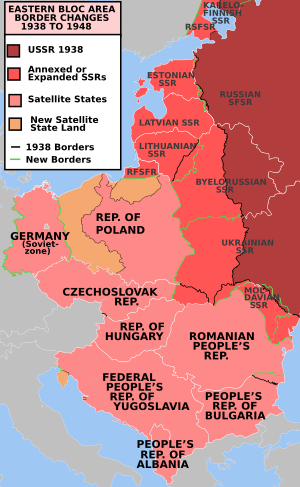
During the opening stages of World War II, the Soviet Union laid the foundation for the Eastern Bloc by invading and then annexing several countries as Soviet Socialist Republics, by agreement with Germany in the Molotov–Ribbentrop Pact. These included eastern Poland (incorporated into the Byelorussian SSR and the Ukrainian SSR),[55] Latvia (which became the Latvian SSR),[56][57] Estonia (which became the Estonian SSR),[56][57] Lithuania (which became the Lithuanian SSR),[56][57] part of eastern Finland (which became the Karelo-Finnish SSR) and eastern Romania (which became the Moldavian SSR).[58]
Central and Eastern European territories that the Soviet army liberated from Germany were added to the Eastern Bloc, pursuant to the Percentages Agreement between Churchill and Stalin. The Soviet Union converted the territories it occupied into satellite states,[59] such as:
- People's Republic of Albania (11 January 1946)[60]
- People's Republic of Bulgaria (15 September 1946)
- Polish People's Republic (19 January 1947)
- People's Republic of Romania (13 April 1948)
- Czechoslovak Socialist Republic (9 May 1948)[61]
- Hungarian People's Republic (20 August 1949)[62]
- German Democratic Republic (7 October 1949)[63]
The Soviet-style regimes that arose in the Bloc not only reproduced Soviet command economy, but also adopted the brutal methods employed by Joseph Stalin and the Soviet secret police in order to suppress both real and potential opposition.[64] In Asia, the Red Army had overrun Manchuria in the last month of the war, and it went on to occupy the large swathe of Korean territory located north of the 38th parallel.[65]
As part of consolidating Stalin's control over the Eastern Bloc, the People's Commissariat for Internal Affairs (NKVD), led by Lavrentiy Beria, supervised the establishment of Soviet-style secret police systems in the Bloc that were supposed to crush anti-communist resistance.[66] When the slightest stirrings of independence emerged in the Bloc, Stalin's strategy matched that of dealing with domestic pre-war rivals: they were removed from power, put on trial, imprisoned, and in several instances, executed.[67]
British Prime Minister Winston Churchill was concerned that, given the enormous size of Soviet forces deployed in Europe at the end of the war, and the perception that Soviet leader Joseph Stalin was unreliable, there existed a Soviet threat to Western Europe.[68] After World War II, US officials guided Western European leaders in establishing their own secret security force to prevent subversion in the Western bloc, which evolved into Operation Gladio.[69]
Containment and the Truman Doctrine (1947–1953)
Iron Curtain, Iran, Turkey, and Greece
In late February 1946, George F. Kennan's "Long Telegram" from Moscow to Washington helped to articulate the US government's increasingly hard line against the Soviets, which would become the basis for US strategy toward the Soviet Union for the duration of the Cold War. The Truman Administration was receptive to the telegram due to broken promises by Stalin concerning Europe and Iran. Following the WWII Anglo-Soviet invasion of Iran, the country was occupied by the Red Army in the far north and the British in the south.[70] Iran was used by the United States and British to supply the Soviet Union, and the Allies agreed to withdraw from Iran within six months after the cessation of hostilities.[70] However, when this deadline came, the Soviets remained in Iran under the guise of the People's Republic of Azerbaijan and Kurdish Republic of Mahabad.[71] Shortly thereafter, on 5 March, former British prime minister Winston Churchill delivered his famous "Iron Curtain" speech in Fulton, Missouri.[72] The speech called for an Anglo-American alliance against the Soviets, whom he accused of establishing an "iron curtain" dividing Europe from "Stettin in the Baltic to Trieste in the Adriatic".[59][73]
A week later, on 13 March, Stalin responded vigorously to the speech, saying that Churchill could be compared to Hitler insofar as he advocated the racial superiority of English-speaking nations so that they could satisfy their hunger for world domination, and that such a declaration was "a call for war on the U.S.S.R." The Soviet leader also dismissed the accusation that the USSR was exerting increasing control over the countries lying in its sphere. He argued that there was nothing surprising in "the fact that the Soviet Union, anxious for its future safety, [was] trying to see to it that governments loyal in their attitude to the Soviet Union should exist in these countries".[74][75]

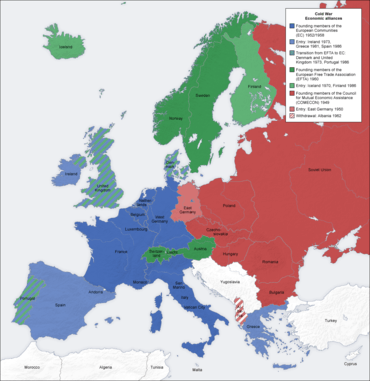
In September, the Soviet side produced the Novikov telegram, sent by the Soviet ambassador to the US but commissioned and "co-authored" by Vyacheslav Molotov; it portrayed the US as being in the grip of monopoly capitalists who were building up military capability "to prepare the conditions for winning world supremacy in a new war".[76] On 6 September 1946, James F. Byrnes delivered a speech in Germany repudiating the Morgenthau Plan (a proposal to partition and de-industrialize post-war Germany) and warning the Soviets that the US intended to maintain a military presence in Europe indefinitely.[77] As Byrnes admitted a month later, "The nub of our program was to win the German people ... it was a battle between us and Russia over minds ..."[78] In December, the Soviets agreed to withdraw from Iran after persistent US pressure, an early success of containment policy.
By 1947, US president Harry S. Truman was outraged by perceived resistance of the Soviet Union to American demands in Iran, Turkey, and Greece, as well as Soviet rejection of the Baruch Plan on nuclear weapons.[79] In February 1947, the British government announced that it could no longer afford to finance the Kingdom of Greece in its civil war against Communist-led insurgents.[80] The US government responded to this announcement by adopting a policy of containment,[81] with the goal of stopping the spread of Communism. Truman delivered a speech calling for the allocation of $400 million to intervene in the war and unveiled the Truman Doctrine, which framed the conflict as a contest between free peoples and totalitarian regimes.[81] American policymakers accused the Soviet Union of conspiring against the Greek royalists in an effort to expand Soviet influence even though Stalin had told the Communist Party to cooperate with the British-backed government.[82] (The insurgents were helped by Josip Broz Tito's Socialist Federal Republic of Yugoslavia against Stalin's wishes.)[83][84]
Enunciation of the Truman Doctrine marked the beginning of a US bipartisan defense and foreign policy consensus between Republicans and Democrats focused on containment and deterrence that weakened during and after the Vietnam War, but ultimately persisted thereafter.[85] Moderate and conservative parties in Europe, as well as social democrats, gave virtually unconditional support to the Western alliance,[86] while European and American Communists, financed by the KGB and involved in its intelligence operations,[87] adhered to Moscow's line, although dissent began to appear after 1956. Other critiques of the consensus policy came from anti-Vietnam War activists, the Campaign for Nuclear Disarmament, and the anti-nuclear movement.[88]
Marshall Plan and Czechoslovak coup d'état

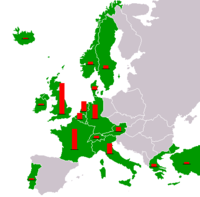

In early 1947, France, Britain and the United States unsuccessfully attempted to reach an agreement with the Soviet Union for a plan envisioning an economically self-sufficient Germany, including a detailed accounting of the industrial plants, goods and infrastructure already removed by the Soviets.[89] In June 1947, in accordance with the Truman Doctrine, the United States enacted the Marshall Plan, a pledge of economic assistance for all European countries willing to participate, including the Soviet Union.[89] Under the plan, which President Harry S. Truman signed on 3 April 1948, the US government gave to Western European countries over $13 billion (equivalent to $189.39 billion in 2016) to rebuild the economy of Europe. Later, the program led to the creation of the Organisation for European Economic Co-operation.
The plan's aim was to rebuild the democratic and economic systems of Europe and to counter perceived threats to Europe's balance of power, such as communist parties seizing control through revolutions or elections.[90] The plan also stated that European prosperity was contingent upon German economic recovery.[91] One month later, Truman signed the National Security Act of 1947, creating a unified Department of Defense, the Central Intelligence Agency (CIA), and the National Security Council (NSC). These would become the main bureaucracies for US defense policy in the Cold War.[92]
Stalin believed that economic integration with the West would allow Eastern Bloc countries to escape Soviet control, and that the US was trying to buy a pro-US re-alignment of Europe.[93] Stalin therefore prevented Eastern Bloc nations from receiving Marshall Plan aid.[93] The Soviet Union's alternative to the Marshall Plan, which was purported to involve Soviet subsidies and trade with central and eastern Europe, became known as the Molotov Plan (later institutionalized in January 1949 as the Council for Mutual Economic Assistance).[83] Stalin was also fearful of a reconstituted Germany; his vision of a post-war Germany did not include the ability to rearm or pose any kind of threat to the Soviet Union.[94]
In early 1948, following reports of strengthening "reactionary elements", Soviet operatives executed a coup d'état in Czechoslovakia, the only Eastern Bloc state that the Soviets had permitted to retain democratic structures.[95] The public brutality of the coup shocked Western powers more than any event up to that point, set in motion a brief scare that war would occur and swept away the last vestiges of opposition to the Marshall Plan in the United States Congress.[96]
The twin policies of the Truman Doctrine and the Marshall Plan led to billions in economic and military aid for Western Europe, Greece, and Turkey. With the US assistance, the Greek military won its civil war.[92] Under the leadership of Alcide De Gasperi the Italian Christian Democrats defeated the powerful Communist–Socialist alliance in the elections of 1948.[97]
Espionage
All major powers engaged in espionage, using a great variety of spies, double agents, and new technologies such as the tapping of telephone cables.[98] The most famous and active organizations were the American CIA,[99] the Soviet KGB,[100] and the British MI6. The East German Stasi, unlike the others, was primarily concerned with internal security, but its Main Directorate for Reconnaissance operated espionage activities around the world.[101] The CIA secretly subsidized and promoted anti-communist cultural activities and organizations.[102] The CIA was also involved in European politics, especially in Italy.[103] Espionage took place all over the world, but Berlin was the most important battleground for spying activity.[104]
So much top secret archival information has been released so that historian Raymond L. Garthoff concludes there probably was parity in the quantity and quality of secret information obtained by each side. However, the Soviets probably had an advantage in terms of HUMINT (espionage) and "sometimes in its reach into high policy circles." In terms of decisive impact, however, he concludes:[105]
- We also can now have high confidence in the judgment that there were no successful "moles" at the political decision-making level on either side. Similarly, there is no evidence, on either side, of any major political or military decision that was prematurely discovered through espionage and thwarted by the other side. There also is no evidence of any major political or military decision that was crucially influenced (much less generated) by an agent of the other side.
In addition to usual espionage, the Western agencies paid special attention to debriefing Eastern Bloc defectors.[106]
Cominform and the Tito–Stalin Split
In September 1947, the Soviets created Cominform, the purpose of which was to enforce orthodoxy within the international communist movement and tighten political control over Soviet satellites through coordination of communist parties in the Eastern Bloc.[93] Cominform faced an embarrassing setback the following June, when the Tito–Stalin Split obliged its members to expel Yugoslavia, which remained communist but adopted a non-aligned position.[107]
Berlin Blockade and Airlift

The United States and Britain merged their western German occupation zones into "Bizonia" (1 January 1947, later "Trizonia" with the addition of France's zone, April 1949).[108] As part of the economic rebuilding of Germany, in early 1948, representatives of a number of Western European governments and the United States announced an agreement for a merger of western German areas into a federal governmental system.[109] In addition, in accordance with the Marshall Plan, they began to re-industrialize and rebuild the west German economy, including the introduction of a new Deutsche Mark currency to replace the old Reichsmark currency that the Soviets had debased.[110] The US had secretly decided that a unified and neutral Germany was undesirable, with Walter Bedell Smith telling General Eisenhower "in spite of our announced position, we really do not want nor intend to accept German unification on any terms that the Russians might agree to, even though they seem to meet most of our requirements."[111]
Shortly thereafter, Stalin instituted the Berlin Blockade (24 June 1948 – 12 May 1949), one of the first major crises of the Cold War, preventing food, materials and supplies from arriving in West Berlin.[112] The United States, Britain, France, Canada, Australia, New Zealand and several other countries began the massive "Berlin airlift", supplying West Berlin with food and other provisions.[113]
The Soviets mounted a public relations campaign against the policy change. Once again the East Berlin communists attempted to disrupt the Berlin municipal elections (as they had done in the 1946 elections),[108] which were held on 5 December 1948 and produced a turnout of 86.3% and an overwhelming victory for the non-communist parties.[114] The results effectively divided the city into East and West versions of its former self. 300,000 Berliners demonstrated and urged the international airlift to continue,[115] and US Air Force pilot Gail Halvorsen created "Operation Vittles", which supplied candy to German children.[116] In May 1949, Stalin backed down and lifted the blockade.[66][117]
In 1952, Stalin repeatedly proposed a plan to unify East and West Germany under a single government chosen in elections supervised by the United Nations, if the new Germany were to stay out of Western military alliances, but this proposal was turned down by the Western powers. Some sources dispute the sincerity of the proposal.[118]
Beginnings of NATO and Radio Free Europe
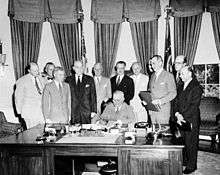
Britain, France, the United States, Canada and other eight western European countries signed the North Atlantic Treaty of April 1949, establishing the North Atlantic Treaty Organization (NATO).[66] That August, the first Soviet atomic device was detonated in Semipalatinsk, Kazakh SSR.[83] Following Soviet refusals to participate in a German rebuilding effort set forth by western European countries in 1948,[109][119] the US, Britain and France spearheaded the establishment of West Germany from the three Western zones of occupation in April 1949.[120] The Soviet Union proclaimed its zone of occupation in Germany the German Democratic Republic that October.[43]
Media in the Eastern Bloc was an organ of the state, completely reliant on and subservient to the communist party. Radio and television organizations were state-owned, while print media was usually owned by political organizations, mostly by the local communist party.[121] Soviet radio broadcasts used Marxist rhetoric to attack capitalism, emphasizing themes of labor exploitation, imperialism and war-mongering.[122]
Along with the broadcasts of the British Broadcasting Corporation (BBC) and the Voice of America to Central and Eastern Europe,[123] a major propaganda effort begun in 1949 was Radio Free Europe/Radio Liberty, dedicated to bringing about the peaceful demise of the communist system in the Eastern Bloc.[124] Radio Free Europe attempted to achieve these goals by serving as a surrogate home radio station, an alternative to the controlled and party-dominated domestic press.[124] Radio Free Europe was a product of some of the most prominent architects of America's early Cold War strategy, especially those who believed that the Cold War would eventually be fought by political rather than military means, such as George F. Kennan.[125]
American policymakers, including Kennan and John Foster Dulles, acknowledged that the Cold War was in its essence a war of ideas.[125] The United States, acting through the CIA, funded a long list of projects to counter the communist appeal among intellectuals in Europe and the developing world.[126] The CIA also covertly sponsored a domestic propaganda campaign called Crusade for Freedom.[127]
In the early 1950s, the US worked for the rearmament of West Germany and, in 1955, secured its full membership of NATO.[43] In May 1953, Beria, by then in a government post, had made an unsuccessful proposal to allow the reunification of a neutral Germany to prevent West Germany's incorporation into NATO.[128]
Chinese Civil War, SEATO, and NSC-68

In 1949, Mao Zedong's People's Liberation Army defeated Chiang Kai-shek's United States-backed Kuomintang (KMT) Nationalist Government in China, and the Soviet Union promptly created an alliance with the newly formed People's Republic of China.[129] According to Norwegian historian Odd Arne Westad, the communists won the Civil War because they made fewer military mistakes than Chiang Kai-Shek made, and because in his search for a powerful centralized government, Chiang antagonized too many interest groups in China. Moreover, his party was weakened during the war against Japan. Meanwhile, the communists told different groups, such as the peasants, exactly what they wanted to hear, and they cloaked themselves under the cover of Chinese nationalism.[130] Chiang and his KMT government retreated to the island of Taiwan.
Confronted with the communist revolution in China and the end of the American atomic monopoly in 1949, the Truman administration quickly moved to escalate and expand its containment doctrine.[83] In NSC 68, a secret 1950 document, the National Security Council instituted a Machiavellian policy [131] while proposing to reinforce pro-Western alliance systems and quadruple spending on defense.[83] Truman, under the influence of advisor Paul Nitze, saw containment as implying complete rollback of Soviet influence in all its forms.[132]
United States officials moved to expand this version of containment into Asia, Africa, and Latin America, in order to counter revolutionary nationalist movements, often led by communist parties financed by the USSR, fighting against the restoration of Europe's colonial empires in South-East Asia and elsewhere. [133] In this way, this US would exercise "preponderant power," oppose neutrality, and establish global hegemony.[132] In the early 1950s (a period sometimes known as the "Pactomania"), the US formalized a series of alliances with Japan, Australia, New Zealand, Thailand and the Philippines (notably ANZUS in 1951 and SEATO in 1954), thereby guaranteeing the United States a number of long-term military bases.[43]
Korean War
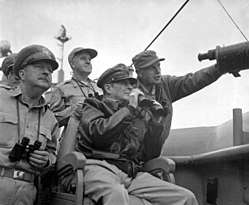
One of the more significant examples of the implementation of containment was US intervention in the Korean War. In June 1950, after years of mutual hostilities,[upper-alpha 6][134][135] Kim Il-sung's North Korean People's Army invaded South Korea at the 38th parallel. Stalin had been reluctant to support the invasion[upper-alpha 7] but ultimately sent advisers.[136] To Stalin's surprise,[83] the United Nations Security Council Resolution 82 and 83 backed the defense of South Korea, although the Soviets were then boycotting meetings in protest of the fact that Taiwan, not the People's Republic of China, held a permanent seat on the council.[137] A UN force of sixteen countries faced North Korea,[138] although 40 percent of troops were South Korean, and about 50 percent were from the United States.[139]
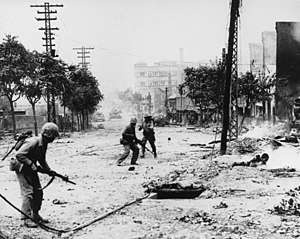
The US initially seemed to follow containment when it first entered the war. This directed the US's action to only push back North Korea across the 38th Parallel and restore South Korea's sovereignty, allowing North Korea's survival as a state. However, the success of the Inchon landing inspired the US and the United Nations to adopt a rollback strategy instead and to overthrow communist North Korea, thus allowing nationwide elections under U.N. auspices.[140] General Douglas MacArthur then advanced across the 38th Parallel into North Korea. The Chinese, fearful of a possible US presence on their border or even an invasion by them, then sent in a large army and defeated the U.N. forces, pushing them back below the 38th parallel. Truman publicly hinted that he might use his "ace in the hole" of the atomic bomb, but Mao was unmoved.[141] The episode was used to support the wisdom of the containment doctrine as opposed to rollback. The Communists were later pushed to roughly around the original border, with minimal changes. Among other effects, the Korean War galvanised NATO to develop a military structure.[142] Public opinion in countries involved, such as Great Britain, was divided for and against the war.[143]
After the Armistice was approved in July 1953, Korean leader Kim Il Sung created a highly centralized, totalitarian dictatorship according his family unlimited power and generating a formidable cult of personality.[144][145] In the South, the American-backed dictator Syngman Rhee ran a deeply violent anticommunist regime.[146] While Rhee was overthrown in 1960, South Korea continued to be ruled by a military government of former Japanese collaborators until the re-establishment of a multi-party system in the late 1980s.[147]
Crisis and escalation (1953–1962)
Khrushchev, Eisenhower and de-Stalinization

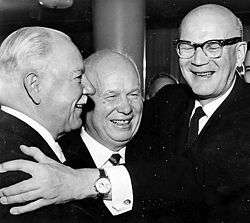
In 1953, changes in political leadership on both sides shifted the dynamic of the Cold War.[92] Dwight D. Eisenhower was inaugurated president that January. During the last 18 months of the Truman administration, the American defense budget had quadrupled, and Eisenhower moved to reduce military spending by a third while continuing to fight the Cold War effectively.[83]
After the death of Joseph Stalin, Nikita Khrushchev became the Soviet leader following the deposition and execution of Lavrentiy Beria and the pushing aside of rivals Georgy Malenkov and Vyacheslav Molotov. On 25 February 1956, Khrushchev shocked delegates to the 20th Congress of the Soviet Communist Party by cataloguing and denouncing Stalin's crimes.[148] As part of a campaign of de-Stalinization, he declared that the only way to reform and move away from Stalin's policies would be to acknowledge errors made in the past.[92]
On 18 November 1956, while addressing Western ambassadors at a reception at the Polish embassy in Moscow, Khrushchev used his famous "Whether you like it or not, history is on our side. We will bury you" expression, shocking everyone present.[upper-alpha 8] He later said that he had not been talking about nuclear war, but rather about the historically determined victory of communism over capitalism.[149] In 1961, Khrushchev declared that even if the USSR was behind the West, within a decade its housing shortage would disappear, consumer goods would be abundant, and within two decades, the "construction of a communist society" in the USSR would be completed "in the main".[150]
Eisenhower's secretary of state, John Foster Dulles, initiated a "New Look" for the containment strategy, calling for a greater reliance on nuclear weapons against US enemies in wartime.[92] Dulles also enunciated the doctrine of "massive retaliation", threatening a severe US response to any Soviet aggression. Possessing nuclear superiority, for example, allowed Eisenhower to face down Soviet threats to intervene in the Middle East during the 1956 Suez Crisis.[83] US plans for nuclear war in the late 1950s included the "systematic destruction" of 1,200 major urban centers in the Eastern Bloc and China, including Moscow, East Berlin and Beijing, with their civilian populations among the primary targets.[151][upper-alpha 9]
In spite of these threats, there were substantial hopes for detente when an upswing in diplomacy took place in 1959, including a two-week visit by Khrushchev to the US, and plans for a two-power summit for May 1960. The latter was disturbed by the U-2 spy plane scandal, however, in which Eisenhower was caught lying to the world about the intrusion of American surveillance aircraft into Soviet territory.[152][153]
Warsaw Pact and Hungarian Revolution
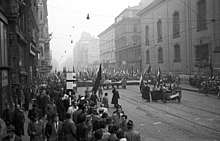

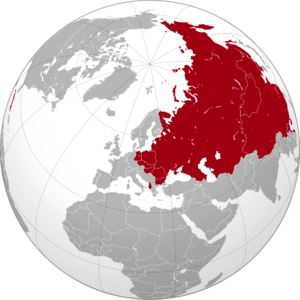
While Stalin's death in 1953 slightly relaxed tensions, the situation in Europe remained an uneasy armed truce.[154] The Soviets, who had already created a network of mutual assistance treaties in the Eastern Bloc by 1949, established a formal alliance therein, the Warsaw Pact, in 1955. It stood opposed to NATO.[43]
The Hungarian Revolution of 1956 occurred shortly after Khrushchev arranged the removal of Hungary's Stalinist leader Mátyás Rákosi.[155] In response to a popular uprising,[upper-alpha 10] the new regime formally disbanded the secret police, declared its intention to withdraw from the Warsaw Pact and pledged to re-establish free elections. The Soviet Army invaded.[156] Thousands of Hungarians were arrested, imprisoned and deported to the Soviet Union,[157] and approximately 200,000 Hungarians fled Hungary in the chaos.[158] Hungarian leader Imre Nagy and others were executed following secret trials.[upper-alpha 11]
From 1957 through 1961, Khrushchev openly and repeatedly threatened the West with nuclear annihilation. He claimed that Soviet missile capabilities were far superior to those of the United States, capable of wiping out any American or European city. According to John Lewis Gaddis, Khrushchev rejected Stalin's "belief in the inevitability of war," however. The new leader declared his ultimate goal was "peaceful coexistence".[159] In Khrushchev's formulation, peace would allow capitalism to collapse on its own,[160] as well as giving the Soviets time to boost their military capabilities,[161] which remained for decades until Gorbachev's later "new thinking" envisioning peaceful coexistence as an end in itself rather than a form of class struggle.[162]
The events in Hungary produced ideological fractures within the communist parties of the world, particularly in Western Europe, with great decline in membership as many in both western and socialist countries felt disillusioned by the brutal Soviet response.[163] The communist parties in the West would never recover from the effect the Hungarian Revolution had on their membership, a fact that was immediately recognized by some, such as the Yugoslavian politician Milovan Đilas who shortly after the revolution was crushed said that "The wound which the Hungarian Revolution inflicted on communism can never be completely healed".[163]
Berlin ultimatum
During November 1958, Khrushchev made an unsuccessful attempt to turn all of Berlin into an independent, demilitarized "free city". He gave the United States, Great Britain, and France a six-month ultimatum to withdraw their troops from the sectors they still occupied in West Berlin, or he would transfer control of Western access rights to the East Germans. Khrushchev earlier explained to Mao Zedong that "Berlin is the testicles of the West. Every time I want to make the West scream, I squeeze on Berlin."[164] NATO formally rejected the ultimatum in mid-December and Khrushchev withdrew it in return for a Geneva conference on the German question.[165]
American military buildup
Kennedy's foreign policy was dominated by American confrontations with the Soviet Union, manifested by proxy contests. Like Truman and Eisenhower, Kennedy supported containment to stop the spread of Communism. President Eisenhower's New Look policy had emphasized the use of less expensive nuclear weapons to deter Soviet aggression by threatening massive nuclear attacks all of the Soviet Union. Nuclear weapons were much cheaper than maintaining a large standing army, so Eisenhower cut conventional forces to save money. Kennedy implemented a new strategy known as flexible response. This strategy relied on conventional arms to achieve limited goals. As part of this policy, Kennedy expanded the United States special operations forces, elite military units that could fight unconventionally in various conflicts. Kennedy hoped that the flexible response strategy would allow the US to counter Soviet influence without resorting to nuclear war.[166]
To support his new strategy Kennedy ordered a massive increase in defense spending. He sought, and Congress provided, a rapid build-up of the nuclear arsenal to restore the lost superiority over the Soviet Union—he claimed in 1960 that Eisenhower had lost it because of excessive concern with budget deficits. In his inaugural address Kennedy promised "to bear any burden" in the defense of liberty, and he repeatedly asked for increases in military spending and authorization of new weapon systems. From 1961 to 1964 the number of nuclear weapons increased by 50 percent, as did the number of B-52 bombers to deliver them. The new ICBM force grew from 63 intercontinental ballistic missiles to 424. He authorized 23 new Polaris submarines, each of which carried 16 nuclear missiles. He called on cities to prepare fallout shelters for nuclear war. In contrast to Eisenhower's warning about the perils of the military-industrial complex, Kennedy focused on rearmament.[167]
Competition in the Third World
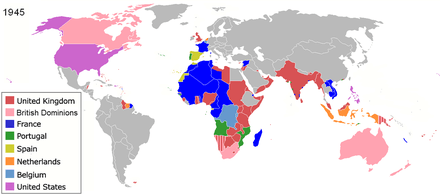
Nationalist movements in some countries and regions, notably Guatemala, Indonesia and Indochina, were often allied with communist groups or otherwise perceived to be unfriendly to Western interests .[92] In this context, the United States and the Soviet Union increasingly competed for influence by proxy in the Third World as decolonization gained momentum in the 1950s and early 1960s.[168] Both sides were selling armaments to gain influence.[169] The Kremlin saw continuing territorial losses by imperial powers as presaging the eventual victory of their ideology.[170]
.jpg)
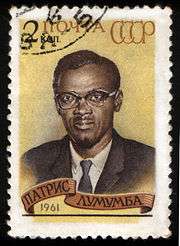
The United States used the Central Intelligence Agency (CIA) to undermine neutral or hostile Third World governments and to support allied ones.[171] In 1953, President Eisenhower implemented Operation Ajax, a covert coup operation to overthrow the Iranian prime minister, Mohammad Mosaddegh. The popularly elected Mosaddegh had been a Middle Eastern nemesis of Britain since nationalizing the British-owned Anglo-Iranian Oil Company in 1951. Winston Churchill told the United States that Mosaddegh was "increasingly turning towards Communist influence."[172][173][174] The pro-Western shah, Mohammad Reza Pahlavi, assumed control as an autocratic monarch.[175] The shah's policies included banning the communist Tudeh Party of Iran, and general suppression of political dissent by SAVAK, the shah's domestic security and intelligence agency.
In Guatemala, a banana republic, the 1954 Guatemalan coup d'état ousted the left-wing President Jacobo Árbenz with material CIA support.[176] The post-Arbenz government—a military junta headed by Carlos Castillo Armas—repealed a progressive land reform law, returned nationalized property belonging to the United Fruit Company, set up a National Committee of Defense Against Communism, and decreed a Preventive Penal Law Against Communism at the request of the United States.[177]
The non-aligned Indonesian government of Sukarno was faced with a major threat to its legitimacy beginning in 1956, when several regional commanders began to demand autonomy from Jakarta. After mediation failed, Sukarno took action to remove the dissident commanders. In February 1958, dissident military commanders in Central Sumatera (Colonel Ahmad Hussein) and North Sulawesi (Colonel Ventje Sumual) declared the Revolutionary Government of the Republic of Indonesia-Permesta Movement aimed at overthrowing the Sukarno regime. They were joined by many civilian politicians from the Masyumi Party, such as Sjafruddin Prawiranegara, who were opposed to the growing influence of the communist Partai Komunis Indonesia party. Due to their anti-communist rhetoric, the rebels received arms, funding, and other covert aid from the CIA until Allen Lawrence Pope, an American pilot, was shot down after a bombing raid on government-held Ambon in April 1958. The central government responded by launching airborne and seaborne military invasions of rebel strongholds Padang and Manado. By the end of 1958, the rebels were militarily defeated, and the last remaining rebel guerilla bands surrendered by August 1961.[178]
In the Republic of the Congo, newly independent from Belgium since June 1960, the CIA-cultivated President Joseph Kasa-Vubu ordered the dismissal of the democratically elected Prime Minister Patrice Lumumba and the Lumumba cabinet in September.[179] In the ensuing Congo Crisis, the CIA-backed Colonel Mobutu Sese Seko quickly mobilized his forces to seize power through a military coup d'état, [179] and worked with Western intelligence agencies to assassinate Lumumba.[180][181]

In British Guiana, the leftist People's Progressive Party (PPP) candidate Cheddi Jagan won the position of chief minister in a colonially administered election in 1953, but was quickly forced to resign from power after Britain's suspension of the still-dependent nation's constitution.[182] Embarrassed by the landslide electoral victory of Jagan's allegedly Marxist party, the British imprisoned the PPP's leadership and maneuvered the organization into a divisive rupture in 1955, engineering a split between Jagan and his PPP colleagues.[183] Jagan again won the colonial elections in 1957 and 1961; despite Britain's shift to a reconsideration of its view of the left-wing Jagan as a Soviet-style communist at this time, the United States pressured the British to withhold Guyana's independence until an alternative to Jagan could be identified, supported, and brought into office.[184]
Worn down by the communist guerrilla war for Vietnamese independence and handed a watershed defeat by communist Viet Minh rebels at the 1954 Battle of Dien Bien Phu, the French accepted a negotiated abandonment of their colonial stake in Vietnam. In the Geneva Conference, peace accords were signed, leaving Vietnam divided between a pro-Soviet administration in North Vietnam and a pro-Western administration in South Vietnam at the 17th parallel north. Between 1954 and 1961, Eisenhower's United States sent economic aid and military advisers to strengthen South Vietnam's pro-Western regime against communist efforts to destabilize it.[83]
Many emerging nations of Asia, Africa, and Latin America rejected the pressure to choose sides in the East–West competition. In 1955, at the Bandung Conference in Indonesia, dozens of Third World governments resolved to stay out of the Cold War.[185] The consensus reached at Bandung culminated with the creation of the Belgrade-headquartered Non-Aligned Movement in 1961.[92] Meanwhile, Khrushchev broadened Moscow's policy to establish ties with India and other key neutral states. Independence movements in the Third World transformed the post-war order into a more pluralistic world of decolonized African and Middle Eastern nations and of rising nationalism in Asia and Latin America.[83]
Sino-Soviet split

After 1956, the Sino-Soviet alliance began to break down. Mao had defended Stalin when Khrushchev criticized him in 1956, and treated the new Soviet leader as a superficial upstart, accusing him of having lost his revolutionary edge.[186] For his part, Khrushchev, disturbed by Mao's glib attitude toward nuclear war, referred to the Chinese leader as a "lunatic on a throne".[187]
After this, Khrushchev made many desperate attempts to reconstitute the Sino-Soviet alliance, but Mao considered it useless and denied any proposal.[186] The Chinese-Soviet animosity spilled out in an intra-communist propaganda war.[188] Further on, the Soviets focused on a bitter rivalry with Mao's China for leadership of the global communist movement.[189] Historian Lorenz M. Lüthi argues:
- The Sino-Soviet split was one of the key events of the Cold War, equal in importance to the construction of the Berlin Wall, the Cuban Missile Crisis, the Second Vietnam War, and Sino-American rapprochement. The split helped to determine the framework of the Second Cold War in general, and influenced the course of the Second Vietnam War in particular.[190]
Space Race

On the nuclear weapons front, the United States and the USSR pursued nuclear rearmament and developed long-range weapons with which they could strike the territory of the other.[43] In August 1957, the Soviets successfully launched the world's first intercontinental ballistic missile (ICBM),[191] and in October they launched the first Earth satellite, Sputnik 1.[192] The launch of Sputnik inaugurated the Space Race. This led to the Apollo Moon landings by the United States, which astronaut Frank Borman later described as "just a battle in the Cold War."[193]
Cuban Revolution and the Bay of Pigs Invasion
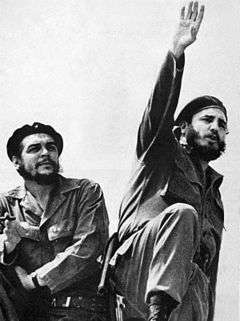
In Cuba, the 26th of July Movement, led by young revolutionaries Fidel Castro and Che Guevara, seized power in the Cuban Revolution on 1 January 1959, toppling President Fulgencio Batista, whose unpopular regime had been denied arms by the Eisenhower administration.[194]
Diplomatic relations between Cuba and the United States continued for some time after Batista's fall, but President Eisenhower deliberately left the capital to avoid meeting Castro during the latter's trip to Washington, DC in April, leaving Vice President Richard Nixon to conduct the meeting in his place.[195] Cuba began negotiating for arms purchases from the Eastern Bloc in March 1960.[196]
In January 1961, just prior to leaving office, Eisenhower formally severed relations with the Cuban government. In April 1961, the administration of newly elected American President John F. Kennedy mounted an unsuccessful CIA-organized ship-borne invasion of the island at Playa Girón and Playa Larga in Santa Clara Province—a failure that publicly humiliated the United States.[197] Castro responded by publicly embracing Marxism–Leninism, and the Soviet Union pledged to provide further support.[197]
Berlin Crisis of 1961

The Berlin Crisis of 1961 was the last major incident in the Cold War regarding the status of Berlin and post–World War II Germany. By the early 1950s, the Soviet approach to restricting emigration movement was emulated by most of the rest of the Eastern Bloc.[198] However, hundreds of thousands of East Germans annually emigrated to West Germany through a "loophole" in the system that existed between East Berlin and West Berlin, where the four occupying World War II powers governed movement.[199]
The emigration resulted in a massive "brain drain" from East Germany to West Germany of younger educated professionals, such that nearly 20% of East Germany's population had migrated to West Germany by 1961.[200] That June, the Soviet Union issued a new ultimatum demanding the withdrawal of Allied forces from West Berlin.[201] The request was rebuffed, and on 13 August, East Germany erected a barbed-wire barrier that would eventually be expanded through construction into the Berlin Wall, effectively closing the loophole.[202]
Cuban Missile Crisis and Khrushchev's ousting

The Kennedy administration continued seeking ways to oust Castro following the Bay of Pigs Invasion, experimenting with various ways of covertly facilitating the overthrow of the Cuban government. Significant hopes were pinned on a covert program named the Cuban Project, devised under the Kennedy administration in 1961. Khrushchev learned of the project in February 1962,[203] and preparations to install Soviet nuclear missiles in Cuba were undertaken in response.[203]
Alarmed, Kennedy considered various reactions. He ultimately responded to the installation of nuclear missiles in Cuba with a naval blockade, and he presented an ultimatum to the Soviets. Khrushchev backed down from a confrontation, and the Soviet Union removed the missiles in return for a public American pledge not to invade Cuba again as well as a covert deal to remove US missiles from Turkey.[204] Castro later admitted that "I would have agreed to the use of nuclear weapons. ... we took it for granted that it would become a nuclear war anyway, and that we were going to disappear."[205]
The Cuban Missile Crisis (October–November 1962) brought the world closer to nuclear war than ever before.[206] The aftermath of the crisis led to the first efforts in the nuclear arms race at nuclear disarmament and improving relations, although the Cold War's first arms control agreement, the Antarctic Treaty, had come into force in 1961.[upper-alpha 12]
In 1964, Khrushchev's Kremlin colleagues managed to oust him, but allowed him a peaceful retirement.[207] Accused of rudeness and incompetence,John Lewis Gaddis argues that Krhuschev was also credited with ruining Soviet agriculture, bringing the world to the brink of Nuclear war[208] and that Khrushchev had become an 'international embarrassment' when he authorized construction of the Berlin Wall.[208]
From confrontation to détente (1962–1979)
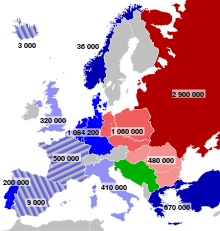
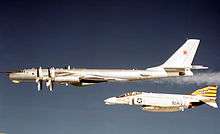
In the course of the 1960s and 1970s, Cold War participants struggled to adjust to a new, more complicated pattern of international relations in which the world was no longer divided into two clearly opposed blocs.[92] From the beginning of the post-war period, Western Europe and Japan rapidly recovered from the destruction of World War II and sustained strong economic growth through the 1950s and 1960s, with per capita GDPs approaching those of the United States, while Eastern Bloc economies stagnated.[92][209]
The Vietnam War descended into a quagmire for the United States, leading to a decline in international prestige and economic stability, derailing arms agreements, and provoking domestic unrest. America's withdrawal from the war led it to embrace a policy of detente with both China and the Soviet Union.[210]
In the 1973 oil crisis, Organization of Petroleum Exporting Countries (OPEC) cut their petroleum output. This raised oil prices and hurt Western economies, but helped the Soviet Union by generating a huge flow of money from its oil sales.[211]
As a result of the oil crisis, combined with the growing influence of Third World alignments such as OPEC and the Non-Aligned Movement, less powerful countries had more room to assert their independence and often showed themselves resistant to pressure from either superpower.[133] Meanwhile, Moscow was forced to turn its attention inward to deal with the Soviet Union's deep-seated domestic economic problems.[92] During this period, Soviet leaders such as Leonid Brezhnev and Alexei Kosygin embraced the notion of détente.[92]
Vietnam War
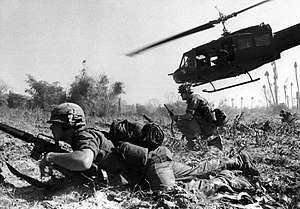
Under President John F. Kennedy, US troop levels in Vietnam grew under the Military Assistance Advisory Group program from just under a thousand in 1959 to 16,000 in 1963.[upper-alpha 13][upper-alpha 14] South Vietnamese President Ngo Dinh Diem's heavy-handed crackdown on Buddhist monks in 1963 led the US to endorse a deadly military coup against Diem.[212] The war escalated further in 1964 following the controversial Gulf of Tonkin incident, in which a U.S. destroyer was alleged to have clashed with North Vietnamese fast attack craft. The Gulf of Tonkin Resolution gave President Lyndon B. Johnson broad authorization to increase U.S. military presence, deploying ground combat units for the first time and increasing troop levels to 184,000.[213] Soviet leader Leonid Brezhnev responded by reversing Khrushchev's policy of disengagement and increasing aid to the North Vietnamese, hoping to entice the North from its pro-Chinese position. The USSR discouraged further escalation of the war, however, providing just enough military assistance to tie up American forces.[214] From this point, the People's Army of Vietnam (PAVN), also known as the North Vietnamese Army (NVA) engaged in more conventional warfare with US and South Vietnamese forces.[215]
The Tet Offensive of 1968 proved to be the turning point of the war. Despite years of American tutelage and aid the South Vietnamese forces were unable to withstand the communist offensive and the task fell to US forces instead. Tet showed that the end of US involvement was not in sight, increasing domestic skepticism of the war and giving rise to what was referred to as the Vietnam Syndrome, a public aversion to American overseas military involvements. Nonetheless operations continued to cross international boundaries: bordering areas of Laos and Cambodia were used by North Vietnam as supply routes, and were heavily bombed by U.S. forces.[216]
At the same time, 1963-65, American domestic politics saw the triumph of liberalism. According to historian Joseph Crespino:
- It has become a staple of twentieth-century historiography that Cold War concerns were at the root of a number of progressive political accomplishments in the postwar period: a high progressive marginal tax rate that helped fund the arms race and contributed to broad income equality; bipartisan support for far-reaching civil rights legislation that transformed politics and society in the American South, which had long given the lie to America’s egalitarian ethos; bipartisan support for overturning an explicitly racist immigration system that had been in place since the 1920s; and free health care for the elderly and the poor, a partial fulfillment of one of the unaccomplished goals of the New Deal era. The list could go on.[217]
French withdrawal from NATO military structures
The unity of NATO was breached early in its history, with a crisis occurring during Charles de Gaulle's presidency of France. De Gaulle protested at the strong role of the United States in the organization and what he perceived as a special relationship between the United States and the United Kingdom. In a memorandum sent to President Dwight D. Eisenhower and Prime Minister Harold Macmillan on 17 September 1958, he argued for the creation of a tripartite directorate that would put France on an equal footing with the United States and the United Kingdom, and also for the expansion of NATO's coverage to include geographical areas of interest to France, most notably French Algeria, where France was waging a counter-insurgency and sought NATO assistance.[218] De Gaulle considered the response he received to be unsatisfactory, and began the development of an independent French nuclear deterrent. In 1966 he withdrew France from NATO's military structures and expelled NATO troops from French soil.[219]
Invasion of Czechoslovakia

In 1968, a period of political liberalization took place in Czechoslovakia called the Prague Spring. An "Action Program" of reforms included increasing freedom of the press, freedom of speech and freedom of movement, along with an economic emphasis on consumer goods, the possibility of a multiparty government, limitations on the power of the secret police,[upper-alpha 15][220] and potential withdrawal from the Warsaw Pact.[221]
In answer to the Prague Spring, on 20 August 1968, the Soviet Army, together with most of their Warsaw Pact allies, invaded Czechoslovakia.[222] The invasion was followed by a wave of emigration, including an estimated 70,000 Czechs and Slovaks initially fleeing, with the total eventually reaching 300,000.[223] The invasion sparked intense protests from Yugoslavia, Romania, China, and from Western European communist parties.[224]
Brezhnev Doctrine

In September 1968, during a speech at the Fifth Congress of the Polish United Workers' Party one month after the invasion of Czechoslovakia, Brezhnev outlined the Brezhnev Doctrine, in which he claimed the right to violate the sovereignty of any country attempting to replace Marxism–Leninism with capitalism. During the speech, Brezhnev stated:[221]
When forces that are hostile to socialism try to turn the development of some socialist country towards capitalism, it becomes not only a problem of the country concerned, but a common problem and concern of all socialist countries.
The doctrine found its origins in the failures of Marxism–Leninism in states like Poland, Hungary and East Germany, which were facing a declining standard of living contrasting with the prosperity of West Germany and the rest of Western Europe.[225]
Third World escalations
Under the Lyndon B. Johnson Administration, which gained power after the assassination of John F. Kennedy, the US took a more hardline stance on Latin America—sometimes called the "Mann Doctrine".[226] In 1964, the Brazilian military overthrew the government of president João Goulart with US backing.[226] In late April 1965, the US sent some 22,000 troops to the Dominican Republic for a one-year occupation in an invasion codenamed Operation Power Pack, citing the threat of the emergence of a Cuban-style revolution in Latin America.[83] Héctor García-Godoy acted as provisional president, until conservative former president Joaquín Balaguer won the 1966 presidential election against non-campaigning former President Juan Bosch.[227] Activists for Bosch's Dominican Revolutionary Party were violently harassed by the Dominican police and armed forces.[227]
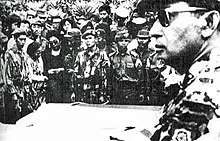
In Indonesia, the hardline anti-communist General Suharto wrested control of the state from his predecessor Sukarno in an attempt to establish a "New Order". From 1965 to 1966, with the aid of the United States and other Western governments,[228][229][230][231][232] the military led the mass killing of more than 500,000 members and sympathizers of the Indonesian Communist Party and other leftist organizations, and detained hundreds of thousands more in prison camps around the country under extremely inhumane conditions.[233][234] A top-secret CIA report stated that the massacres "rank as one of the worst mass murders of the 20th century, along with the Soviet purges of the 1930s, the Nazi mass murders during the Second World War, and the Maoist bloodbath of the early 1950s."[234] These killings served US strategic interests and constitute a major turning point in the Cold War as the balance of power shifted in Southeast Asia.[232][235]
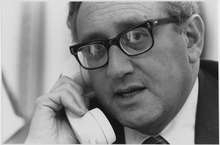
Escalating the scale of American intervention in the ongoing conflict between Ngô Đình Diệm's South Vietnamese government and the communist National Front for the Liberation of South Vietnam (NLF) insurgents opposing it, Johnson deployed some 575,000 troops in Southeast Asia to defeat the NLF and their North Vietnamese allies in the Vietnam War, but his costly policy weakened the US economy and, by 1975, it ultimately culminated in what most of the world saw as a humiliating defeat of the world's most powerful superpower at the hands of one of the world's poorest nations.[83]

The Middle East remained a source of contention. Egypt, which received the bulk of its arms and economic assistance from the USSR, was a troublesome client, with a reluctant Soviet Union feeling obliged to assist in both the 1967 Six-Day War (with advisers and technicians) and the War of Attrition (with pilots and aircraft) against pro-Western Israel.[236] Despite the beginning of an Egyptian shift from a pro-Soviet to a pro-American orientation in 1972 (under Egypt's new leader Anwar Sadat),[237] rumors of imminent Soviet intervention on the Egyptians' behalf during the 1973 Yom Kippur War brought about a massive American mobilization that threatened to wreck détente. Although pre-Sadat Egypt had been the largest recipient of Soviet aid in the Middle East, the Soviets were also successful in establishing close relations with communist South Yemen, as well as the nationalist governments of Algeria and Iraq.[237] Iraq signed a 15-year Treaty of Friendship and Cooperation with the Soviet Union in 1972. According to historian Charles R.H. Tripp, the treaty upset "the US-sponsored security system established as part of the Cold War in the Middle East. It appeared that any enemy of the Baghdad regime was a potential ally of the United States."[238] In response, the US covertly financed Kurdish rebels led by Mustafa Barzani during the Second Iraqi–Kurdish War; the Kurds were defeated in 1975, leading to the forcible relocation of hundreds of thousands of Kurdish civilians.[238] Indirect Soviet assistance to the Palestinian side of the Israeli–Palestinian conflict included support for Yasser Arafat's Palestine Liberation Organization (PLO).[239]

In East Africa, a territorial dispute between Somalia and Ethiopia over the Ogaden region resulted in the Ogaden War. Around June 1977, Somali troops occupied the Ogaden and began advancing inland towards Ethiopian positions in the Ahmar Mountains. Both countries were client states of the Soviet Union; Somalia was led by self-proclaimed Marxist military leader Siad Barre, and Ethiopia was controlled by the Derg, a cabal of military generals loyal to the pro-Soviet Mengistu Haile Mariam, who had declared the Provisional Military Government of Socialist Ethiopia in 1975.[240] The Soviets initially attempted to exert a moderating influence on both states, but in November 1977 Barre broke off relations with Moscow and expelled his Soviet military advisers.[241] He then turned to the China and Safari Club—a group of pro-American intelligence agencies including those of Iran, Egypt, Saudi Arabia—for support and weapons.[242][243][upper-alpha 16] While declining to take a direct part in hostilities, the Soviet Union did provide the impetus for a successful Ethiopian counteroffensive to expel Somalia from the Ogaden. The counteroffensive was planned at the command level by Soviet advisers attached to the Ethiopian general staff, and bolstered by the delivery of millions of dollars' of sophisticated Soviet arms.[241] About 11,000 Cuban troops spearheaded the primary effort, after receiving a hasty training on some of the newly delivered Soviet weapons systems by East German instructors.[241]
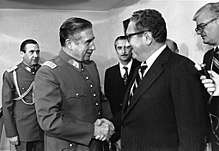
In Chile, the Socialist Party candidate Salvador Allende won the presidential election of 1970, becoming the first democratically elected Marxist to become president of a country in the Americas.[244] The CIA targeted Allende for removal and operated to undermine his support domestically, which contributed to a period of unrest culminating in General Augusto Pinochet's coup d'état on 11 September 1973. Pinochet consolidated power as a military dictator, Allende's reforms of the economy were rolled back, and leftist opponents were killed or detained in internment camps under the Dirección de Inteligencia Nacional (DINA). The Socialist states—with the exception of China and Romania—broke off relations with Chile.[245] The Pinochet regime would go on to be one of the leading participants in Operation Condor, an international campaign of political assassination and state terrorism organized by right-wing military dictatorships in the Southern Cone of South America that was covertly supported by the US government.[246][247][248]
On 24 April 1974, the Carnation Revolution ousted Marcelo Caetano and Portugal's right-wing Estado Novo government, sounding the death knell for the Portuguese Empire.[249] Independence was hastily granted to a number of Portuguese colonies, including Angola, where the disintegration of colonial rule was followed by a violent civil war.[250] There were three rival militant factions competing for power in Angola, the People's Movement for the Liberation of Angola (MPLA), the National Union for the Total Independence of Angola (UNITA), and the National Liberation Front of Angola (FNLA).[251] While all three had socialist leanings, the MPLA was the only party with close ties to the Soviet Union.[251] Its adherence to the concept of a one-party state alienated it from the FNLA and UNITA, which began portraying themselves as anti-communist and pro-Western in orientation.[251] When the Soviets began supplying the MPLA with arms, the CIA and China offered substantial covert aid to the FNLA and UNITA.[252][253][254] The MPLA eventually requested direct military support from Moscow in the form of ground troops, but the Soviets declined, offering to send advisers but no combat personnel.[252] Cuba was more forthcoming and began amassing troops in Angola to assist the MPLA.[252] By November 1975 there were over a thousand Cuban soldiers in the country.[252] The persistent buildup of Cuban troops and Soviet weapons allowed the MPLA to secure victory and blunt an abortive intervention by Zairean and South African troops, which had deployed in a belated attempt to assist the FNLA and UNITA.[255]
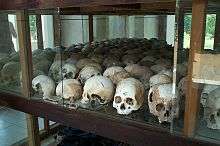
During the Vietnam War, North Vietnam used border areas of Cambodia as military bases, which Cambodian head of state Norodom Sihanouk tolerated in an attempt to preserve Cambodia's neutrality. Following Sihanouk's March 1970 deposition by pro-American general Lon Nol, who ordered the North Vietnamese to leave Cambodia, North Vietnam attempted to overrun all of Cambodia following negotiations with Nuon Chea, the second-in-command of the Cambodian communists (dubbed the Khmer Rouge) fighting to overthrow the Cambodian government.[256] Sihanouk fled to China with the establishment of the GRUNK in Beijing.[257] American and South Vietnamese forces responded to these actions with a bombing campaign and a brief ground incursion, which contributed to the violence of the civil war that soon enveloped all of Cambodia.[258] US carpet bombing lasted until 1973, and while it prevented the Khmer Rouge from seizing the capital, it also accelerated the collapse of rural society, increased social polarization,[259] and killed tens of thousands of civilians.[260]
After taking power and distancing himself from the Vietnamese,[261] pro-China Khmer Rouge leader Pol Pot killed 1.5 to 2 million Cambodians in the killing fields, roughly a quarter of the Cambodian population (an event commonly labelled the Cambodian genocide).[262][263][264][265] Martin Shaw described these atrocities as "the purest genocide of the Cold War era."[266] Backed by the Kampuchean United Front for National Salvation, an organization of Khmer pro-Soviet Communists and Khmer Rouge defectors led by Heng Samrin, Vietnam invaded Cambodia on 22 December 1978. The invasion succeeded in deposing Pol Pot, but the new state would struggle to gain international recognition beyond the Soviet Bloc sphere, despite the previous international outcry at the Pol Pot regime's gross human rights violations, representatives of Khmer Rouge were allowed to be seated in the UN General Assembly, with strong support from China and Western powers, the member countries of ASEAN, and it would become bogged down in a guerrilla war led from refugee camps located on the border with Thailand. Following the destruction of Khmer Rouge, the national reconstruction of Cambodia would be severely hampered, and Vietnam would suffer a punitive Chinese attack.[267]
Sino-American rapprochement

As a result of the Sino-Soviet split, tensions along the Chinese–Soviet border reached their peak in 1969, and United States President Richard Nixon decided to use the conflict to shift the balance of power towards the West in the Cold War.[268] The Chinese had sought improved relations with the Americans in order to gain advantage over the Soviets as well.
In February 1972, Nixon achieved a stunning rapprochement with China,[269] traveling to Beijing and meeting with Mao Zedong and Zhou Enlai. At this time, the USSR achieved rough nuclear parity with the United States; meanwhile, the Vietnam War both weakened America's influence in the Third World and cooled relations with Western Europe.
Although indirect conflict between Cold War powers continued through the late 1960s and early 1970s, tensions were beginning to ease.
Nixon, Brezhnev, and détente
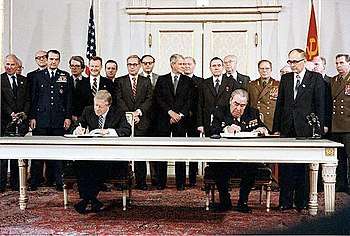
Following his visit to China, Nixon met with Soviet leaders, including Brezhnev in Moscow.[270] These Strategic Arms Limitation Talks resulted in two landmark arms control treaties: SALT I, the first comprehensive limitation pact signed by the two superpowers, and the Anti-Ballistic Missile Treaty, which banned the development of systems designed to intercept incoming missiles. These aimed to limit the development of costly anti-ballistic missiles and nuclear missiles.[92]
Nixon and Brezhnev proclaimed a new era of "peaceful coexistence" and established the groundbreaking new policy of détente (or cooperation) between the two superpowers. Meanwhile, Brezhnev attempted to revive the Soviet economy, which was declining in part because of heavy military expenditures. Between 1972 and 1974, the two sides also agreed to strengthen their economic ties,[83] including agreements for increased trade. As a result of their meetings, détente would replace the hostility of the Cold War and the two countries would live mutually.[271]
These developments coincided with Bonn's "Ostpolitik" policy formulated by the West German Chancellor Willy Brandt,[224] an effort to normalize relations between West Germany and Eastern Europe. Other agreements were concluded to stabilize the situation in Europe, culminating in the Helsinki Accords signed at the Conference on Security and Co-operation in Europe in 1975.[272]
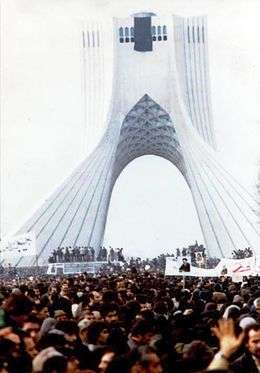
Kissinger and Nixon were "realists" who deemphasized idealistic goals like anti-communism or promotion of democracy worldwide, because those goals were too expensive in terms of America's economic capabilities.[273] Instead of a Cold War they wanted peace, trade and cultural exchanges. They realized that Americans were no longer willing to tax themselves for idealistic foreign policy goals, especially for containment policies that never seemed to produce positive results. Instead Nixon and Kissinger sought to downsize America's global commitments in proportion to its reduced economic, moral and political power. They rejected "idealism" as impractical and too expensive, and neither man showed much sensitivity to the plight of people living under Communism. Kissinger's realism fell out of fashion as idealism returned to American foreign policy with Carter's moralism emphasizing human rights, and Reagan's rollback strategy aimed at destroying Communism.[274]
Late 1970s deterioration of relations
In the 1970s, the KGB, led by Yuri Andropov, continued to persecute distinguished Soviet personalities such as Aleksandr Solzhenitsyn and Andrei Sakharov, who were criticising the Soviet leadership in harsh terms.[275] Indirect conflict between the superpowers continued through this period of détente in the Third World, particularly during political crises in the Middle East, Chile, Ethiopia, and Angola.[276]
Although President Jimmy Carter tried to place another limit on the arms race with a SALT II agreement in 1979,[277] his efforts were undermined by the other events that year, including the Iranian Revolution and the Nicaraguan Revolution, which both ousted pro-US regimes, and his retaliation against Soviet intervention in Afghanistan in December.[83]
New Cold War (1979–1985)

The term new Cold War refers to the period of intensive reawakening of Cold War tensions and conflicts in the late 1970s and early 1980s. Tensions greatly increased between the major powers with both sides becoming more militant.[278] Diggins says, "Reagan went all out to fight the second cold war, by supporting counterinsurgencies in the third world."[279] Cox says, "The intensity of this 'second' Cold War was as great as its duration was short."[280]
Soviet War in Afghanistan
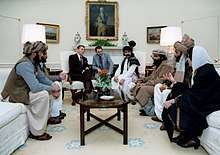
In April 1978, the communist People's Democratic Party of Afghanistan (PDPA) seized power in Afghanistan in the Saur Revolution. Within months, opponents of the communist government launched an uprising in eastern Afghanistan that quickly expanded into a civil war waged by guerrilla mujahideen against government forces countrywide.[281] The Islamic Unity of Afghanistan Mujahideen insurgents received military training and weapons in neighboring Pakistan and China,[282][283] while the Soviet Union sent thousands of military advisers to support the PDPA government.[281] Meanwhile, increasing friction between the competing factions of the PDPA—the dominant Khalq and the more moderate Parcham—resulted in the dismissal of Parchami cabinet members and the arrest of Parchami military officers under the pretext of a Parchami coup. By mid-1979, the United States had started a covert program to assist the mujahideen.[284]
In September 1979, Khalqist President Nur Muhammad Taraki was assassinated in a coup within the PDPA orchestrated by fellow Khalq member Hafizullah Amin, who assumed the presidency. Distrusted by the Soviets, Amin was assassinated by Soviet special forces in December 1979. A Soviet-organized government, led by Parcham's Babrak Karmal but inclusive of both factions, filled the vacuum. Soviet troops were deployed to stabilize Afghanistan under Karmal in more substantial numbers, although the Soviet government did not expect to do most of the fighting in Afghanistan. As a result, however, the Soviets were now directly involved in what had been a domestic war in Afghanistan.[285]
Carter responded to the Soviet intervention by withdrawing the SALT II treaty from ratification, imposing embargoes on grain and technology shipments to the USSR, and demanding a significant increase in military spending, and further announced that the United States would boycott the 1980 Summer Olympics in Moscow. He described the Soviet incursion as "the most serious threat to the peace since the Second World War".[286]
Reagan and Thatcher

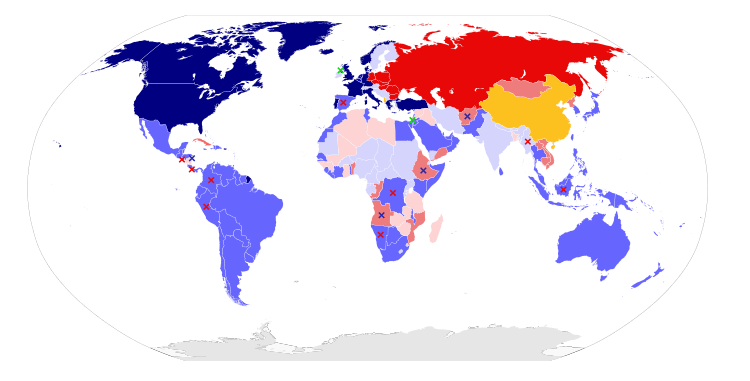
In January 1977, four years prior to becoming president, Ronald Reagan bluntly stated, in a conversation with Richard V. Allen, his basic expectation in relation to the Cold War. "My idea of American policy toward the Soviet Union is simple, and some would say simplistic," he said. "It is this: We win and they lose. What do you think of that?"[287] In 1980, Ronald Reagan defeated Jimmy Carter in the 1980 presidential election, vowing to increase military spending and confront the Soviets everywhere.[288] Both Reagan and new British Prime Minister Margaret Thatcher denounced the Soviet Union and its ideology. Reagan labeled the Soviet Union an "evil empire" and predicted that Communism would be left on the "ash heap of history," while Thatcher inculpated the Soviets as "bent on world dominance."[289][290] In 1982, Reagan tried to cut off Moscow's access to hard currency by impeding its proposed gas line to Western Europe. It hurt the Soviet economy, but it also caused ill will among American allies in Europe who counted on that revenue. Reagan retreated on this issue.[291][292]
By early 1985, Reagan's anti-communist position had developed into a stance known as the new Reagan Doctrine—which, in addition to containment, formulated an additional right to subvert existing communist governments.[293] Besides continuing Carter's policy of supporting the Islamic opponents of the Soviet Union and the Soviet-backed PDPA government in Afghanistan, the CIA also sought to weaken the Soviet Union itself by promoting Islamism in the majority-Muslim Central Asian Soviet Union.[294] Additionally, the CIA encouraged anti-communist Pakistan's ISI to train Muslims from around the world to participate in the jihad against the Soviet Union.[294]
Polish Solidarity movement and martial law
Pope John Paul II provided a moral focus for anti-communism; a visit to his native Poland in 1979 stimulated a religious and nationalist resurgence centered on the Solidarity movement that galvanized opposition and may have led to his attempted assassination two years later. In December 1981, Poland's Wojciech Jaruzelski reacted to the crisis by imposing a period of martial law. Reagan imposed economic sanctions on Poland in response.[295] Mikhail Suslov, the Kremlin's top ideologist, advised Soviet leaders not to intervene if Poland fell under the control of Solidarity, for fear it might lead to heavy economic sanctions, resulting in a catastrophe for the Soviet economy.[295]
Soviet and US military and economic issues
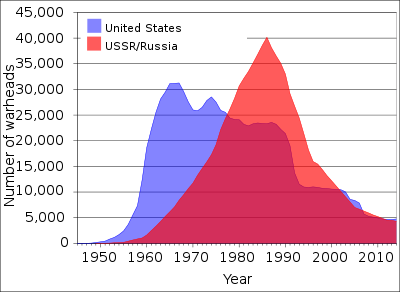
The Soviet Union had built up a military that consumed as much as 25 percent of its gross national product at the expense of consumer goods and investment in civilian sectors.[296] Soviet spending on the arms race and other Cold War commitments both caused and exacerbated deep-seated structural problems in the Soviet system,[297] which experienced at least a decade of economic stagnation during the late Brezhnev years.
Soviet investment in the defense sector was not driven by military necessity, but in large part by the interests of massive party and state bureaucracies dependent on the sector for their own power and privileges.[298] The Soviet Armed Forces became the largest in the world in terms of the numbers and types of weapons they possessed, in the number of troops in their ranks, and in the sheer size of their military–industrial base.[299] However, the quantitative advantages held by the Soviet military often concealed areas where the Eastern Bloc dramatically lagged behind the West.[300] For example, the Persian Gulf War demonstrated how the armor, fire control systems and firing range of the Soviet Union's most common main battle tank, the T-72, were drastically inferior to the American M1 Abrams, yet the USSR fielded almost three times as many T-72s as the US deployed M1s.[301]

By the early 1980s, the USSR had built up a military arsenal and army surpassing that of the United States. Soon after the Soviet invasion of Afghanistan, president Carter began massively building up the United States military. This buildup was accelerated by the Reagan administration, which increased the military spending from 5.3 percent of GNP in 1981 to 6.5 percent in 1986,[302] the largest peacetime defense buildup in United States history.[303]
Tensions continued to intensify as Reagan revived the B-1 Lancer program, which had been canceled by the Carter administration, produced LGM-118 Peacekeeper missiles,[304] installed US cruise missiles in Europe, and announced the experimental Strategic Defense Initiative, dubbed "Star Wars" by the media, a defense program to shoot down missiles in mid-flight. The Soviets deployed RSD-10 Pioneer ballistic missiles targeting Western Europe, and NATO decided, under the impetus of the Carter presidency, to deploy MGM-31 Pershing and cruise missiles in Europe, primarily West Germany.[305] This deployment placed missiles just 10 minutes' striking distance from Moscow.[306]
After Reagan's military buildup, the Soviet Union did not respond by further building its military,[307] because the enormous military expenses, along with inefficient planned manufacturing and collectivized agriculture, were already a heavy burden for the Soviet economy.[308] At the same time, Saudi Arabia increased oil production,[309] even as other non-OPEC nations were increasing production.[upper-alpha 17] These developments contributed to the 1980s oil glut, which affected the Soviet Union as oil was the main source of Soviet export revenues.[296] Issues with command economics,[310] oil price decreases and large military expenditures gradually brought the Soviet economy to stagnation.
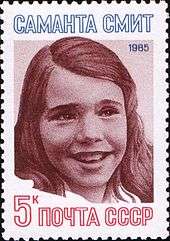
On 1 September 1983, the Soviet Union shot down Korean Air Lines Flight 007, a Boeing 747 with 269 people aboard, including sitting Congressman Larry McDonald, an action which Reagan characterized as a "massacre". The airliner had violated Soviet airspace just past the west coast of Sakhalin Island near Moneron Island, and the Soviets treated the unidentified aircraft as an intruding US spy plane. The incident increased support for military deployment, overseen by Reagan, which stood in place until the later accords between Reagan and Mikhail Gorbachev.[311] The Able Archer 83 exercise in November 1983, a realistic simulation of a coordinated NATO nuclear release, was perhaps the most dangerous moment since the Cuban Missile Crisis, as the Soviet leadership feared that a nuclear attack might be imminent.[312]
American domestic public concerns about intervening in foreign conflicts persisted from the end of the Vietnam War.[313] The Reagan administration emphasized the use of quick, low-cost counter-insurgency tactics to intervene in foreign conflicts.[313] In 1983, the Reagan administration intervened in the multisided Lebanese Civil War, invaded Grenada, bombed Libya and backed the Central American Contras, anti-communist paramilitaries seeking to overthrow the Soviet-aligned Sandinista government in Nicaragua.[133] While Reagan's interventions against Grenada and Libya were popular in the United States, his backing of the Contra rebels was mired in controversy.[314] The Reagan administration's backing of the military government of Guatemala during the Guatemalan Civil War, in particular the regime of Efraín Ríos Montt, was also controversial.[315]
Meanwhile, the Soviets incurred high costs for their own foreign interventions. Although Brezhnev was convinced in 1979 that the Soviet war in Afghanistan would be brief, Muslim guerrillas, aided by the US, China, Britain, Saudi Arabia and Pakistan,[283] waged a fierce resistance against the invasion.[316] The Kremlin sent nearly 100,000 troops to support its puppet regime in Afghanistan, leading many outside observers to dub the war "the Soviets' Vietnam".[316] However, Moscow's quagmire in Afghanistan was far more disastrous for the Soviets than Vietnam had been for the Americans because the conflict coincided with a period of internal decay and domestic crisis in the Soviet system.
A senior US State Department official predicted such an outcome as early as 1980, positing that the invasion resulted in part from a "domestic crisis within the Soviet system. ... It may be that the thermodynamic law of entropy has ... caught up with the Soviet system, which now seems to expend more energy on simply maintaining its equilibrium than on improving itself. We could be seeing a period of foreign movement at a time of internal decay".[317]
Final years (1985–1991)
Gorbachev's reforms

By the time the comparatively youthful Mikhail Gorbachev became General Secretary in 1985,[289] the Soviet economy was stagnant and faced a sharp fall in foreign currency earnings as a result of the downward slide in oil prices in the 1980s.[318] These issues prompted Gorbachev to investigate measures to revive the ailing state.[318]
An ineffectual start led to the conclusion that deeper structural changes were necessary, and in June 1987 Gorbachev announced an agenda of economic reform called perestroika, or restructuring.[319] Perestroika relaxed the production quota system, allowed private ownership of businesses and paved the way for foreign investment. These measures were intended to redirect the country's resources from costly Cold War military commitments to more productive areas in the civilian sector.[319]
Despite initial skepticism in the West, the new Soviet leader proved to be committed to reversing the Soviet Union's deteriorating economic condition instead of continuing the arms race with the West.[320] Partly as a way to fight off internal opposition from party cliques to his reforms, Gorbachev simultaneously introduced glasnost, or openness, which increased freedom of the press and the transparency of state institutions.[321] Glasnost was intended to reduce the corruption at the top of the Communist Party and moderate the abuse of power in the Central Committee.[322] Glasnost also enabled increased contact between Soviet citizens and the western world, particularly with the United States, contributing to the accelerating détente between the two nations.[323]
Thaw in relations

In response to the Kremlin's military and political concessions, Reagan agreed to renew talks on economic issues and the scaling-back of the arms race.[324] The first summit was held in November 1985 in Geneva, Switzerland.[324] At one stage the two men, accompanied only by an interpreter, agreed in principle to reduce each country's nuclear arsenal by 50 percent.[325] A second summit was held in October 1986 in Reykjavík, Iceland. Talks went well until the focus shifted to Reagan's proposed Strategic Defense Initiative, which Gorbachev wanted eliminated. Reagan refused.[326] The negotiations failed, but the third summit in 1987 led to a breakthrough with the signing of the Intermediate-Range Nuclear Forces Treaty (INF). The INF treaty eliminated all nuclear-armed, ground-launched ballistic and cruise missiles with ranges between 500 and 5,500 kilometers (300 to 3,400 miles) and their infrastructure.[327]
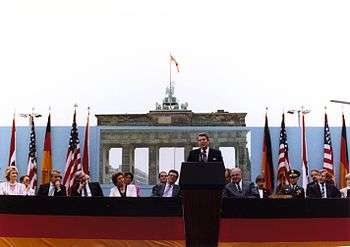
East–West tensions rapidly subsided through the mid-to-late 1980s, culminating with the final summit in Moscow in 1989, when Gorbachev and George H. W. Bush signed the START I arms control treaty.[328] During the following year it became apparent to the Soviets that oil and gas subsidies, along with the cost of maintaining massive troops levels, represented a substantial economic drain.[329] In addition, the security advantage of a buffer zone was recognised as irrelevant and the Soviets officially declared that they would no longer intervene in the affairs of allied states in Central and Eastern Europe.[330]
In 1989, Soviet forces withdrew from Afghanistan,[331] and by 1990 Gorbachev consented to German reunification,[329] as the only alternative was a Tiananmen Square scenario.[332] When the Berlin Wall came down, Gorbachev's "Common European Home" concept began to take shape.[333]
On 3 December 1989, Gorbachev and George H.W. Bush declared the Cold War over at the Malta Summit.[334] A year later, the two former rivals were partners in the Gulf War against Iraq (August 1990 – February 1991).[335]
Eastern Europe breaks away
By 1989, the Soviet alliance system was on the brink of collapse, and, deprived of Soviet military support, the communist leaders of the Warsaw Pact states were losing power.[336] Grassroots organizations, such as Poland's Solidarity movement, rapidly gained ground with strong popular bases. In 1989, the communist governments in Poland and Hungary became the first to negotiate the organization of competitive elections. In Czechoslovakia and East Germany, mass protests unseated entrenched communist leaders. The communist regimes in Bulgaria and Romania also crumbled, in the latter case as the result of a violent uprising. Attitudes had changed enough that US Secretary of State James Baker suggested that the American government would not be opposed to Soviet intervention in Romania, on behalf of the opposition, to prevent bloodshed.[337] The tidal wave of change culminated with the fall of the Berlin Wall in November 1989, which symbolized the collapse of European communist governments and graphically ended the Iron Curtain divide of Europe. The 1989 revolutionary wave swept across Central and Eastern Europe and peacefully overthrew all of the Soviet-style Marxist–Leninist states: East Germany, Poland, Hungary, Czechoslovakia and Bulgaria;[338] Romania was the only Eastern-bloc country to topple its communist regime violently and execute its head of state.[339]
Soviet dissolution

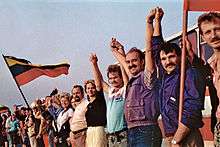
In the USSR itself, glasnost weakened the ideological bonds that held the Soviet Union together, and by February 1990, with the dissolution of the USSR looming, the Communist Party was forced to surrender its 73-year-old monopoly on state power.[340] At the same time the union's component republics declared their autonomy from Moscow, with the Baltic states withdrawing from the union entirely.[341]
Gorbachev used force to keep the Baltics from braking away. The USSR was fatally weakened by a failed coup in August 1991. A growing number of Soviet republics, particularly Russia, threatened to secede from the USSR. The Commonwealth of Independent States, created on 21 December 1991, was a successor entity to the Soviet Union.[upper-alpha 18] The USSR was declared officially dissolved on 26 December 1991.[342]
US President George H.W. Bush expressed his emotions: "The biggest thing that has happened in the world in my life, in our lives, is this: By the grace of God, America won the Cold War."[343]
Aftermath
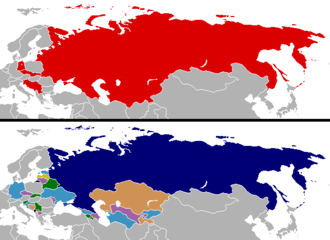
After the dissolution of the Soviet Union, Russia drastically cut military spending, and restructuring the economy left millions unemployed.[344] The capitalist reforms culminated in a recession in the early 1990s more severe than the Great Depression as experienced by the United States and Germany.[345] In the 25 years following the end of the Cold War, only five or six of the post-socialist states are on a path to joining the rich and capitalist world while most are falling behind, some to such an extent that it will take several decades to catch up to where they were before the collapse of communism.[346][347]
The Cold War continues to influence world affairs. The post-Cold War world is considered to be unipolar, with the United States the sole remaining superpower.[upper-alpha 19][348] The Cold War defined the political role of the United States after World War II—by 1989 the United States had military alliances with 50 countries, with 526,000 troops stationed abroad,[349] with 326,000 in Europe (two-thirds of which were in West Germany)[350] and 130,000 in Asia (mainly Japan and South Korea).[349] The Cold War also marked the zenith of peacetime military–industrial complexes, especially in the United States, and large-scale military funding of science.[351] These complexes, though their origins may be found as early as the 19th century, snowballed considerably during the Cold War.[352]

Cumulative US military expenditures throughout the entire Cold War amounted to an estimated $8 trillion. Further nearly 100,000 Americans lost their lives in the Korean and Vietnam Wars.[353] Although Soviet casualties are difficult to estimate, as a share of gross national product the financial cost for the Soviet Union was much higher than that incurred by the United States.[354]
In addition to the loss of life by uniformed soldiers, millions died in the superpowers' proxy wars around the globe, most notably in Southeast Asia.[355] Most of the proxy wars and subsidies for local conflicts ended along with the Cold War; interstate wars, ethnic wars, revolutionary wars, as well as refugee and displaced persons crises have declined sharply in the post-Cold War years.[upper-alpha 20]
However, the aftermath of the Cold War is not considered to be concluded. Many of the economic and social tensions that were exploited to fuel Cold War competition in parts of the Third World remain acute. The breakdown of state control in a number of areas formerly ruled by communist governments produced new civil and ethnic conflicts, particularly in the former Yugoslavia. In Central and Eastern Europe, the end of the Cold War has ushered in an era of economic growth and an increase in the number of liberal democracies, while in other parts of the world, such as Afghanistan, independence was accompanied by state failure.[278]
In popular culture
During the Cold War, the United States and the Soviet Union invested heavily in propaganda designed to influence people around the world, especially using motion pictures.[356] The Cold War endures as a popular topic reflected extensively in entertainment media, and continuing to the present with numerous post-1991 Cold War-themed feature films, novels, television, and other media. In 2013, a KGB-sleeper-agents-living-next-door action drama series, The Americans, set in the early 1980s, was ranked No. 6 on the Metacritic annual Best New TV Shows list; its six-season run concluded in May 2018.[357][358]
Historiography
As soon as the term "Cold War" was popularized to refer to post-war tensions between the United States and the Soviet Union, interpreting the course and origins of the conflict has been a source of heated controversy among historians, political scientists, and journalists.[359] In particular, historians have sharply disagreed as to who was responsible for the breakdown of Soviet–US relations after the Second World War; and whether the conflict between the two superpowers was inevitable, or could have been avoided.[360] Historians have also disagreed on what exactly the Cold War was, what the sources of the conflict were, and how to disentangle patterns of action and reaction between the two sides.[278]
Although explanations of the origins of the conflict in academic discussions are complex and diverse, several general schools of thought on the subject can be identified. Historians commonly speak of three differing approaches to the study of the Cold War: "orthodox" accounts, "revisionism", and "post-revisionism".[351]
"Orthodox" accounts place responsibility for the Cold War on the Soviet Union and its expansion further into Europe.[351] "Revisionist" writers place more responsibility for the breakdown of post-war peace on the United States, citing a range of US efforts to isolate and confront the Soviet Union well before the end of World War II.[351] "Post-revisionists" see the events of the Cold War as more nuanced, and attempt to be more balanced in determining what occurred during the Cold War.[351] Much of the historiography on the Cold War weaves together two or even all three of these broad categories.[43]
See also
- American espionage in the Soviet Union and Russian Federation
- American imperialism
- Canada in the Cold War
- Cold War (TV series)
- List of Americans in the Venona papers
- List of Eastern Bloc agents in the United States
- McCarthyism
- Outline of the Cold War
- Red Scare
- Soviet Empire
- Soviet espionage in the United States
- Timeline of events in the Cold War
- War on Terror
- World War III
- Venona project
- Category:Cold War by period
Footnotes
- "Where did banana republics get their name?" The Economist, 21 November 2013
- Strobe Talbott, The Great Experiment: The Story of Ancient Empires, Modern States, and the Quest for a Global Nation (2009) p. 441 n. 3; Lippmann's own book is Lippmann, Walter (1947). The Cold War. Harper.
- "Left Communist | Russian political faction". Encyclopedia Britannica. Retrieved 30 September 2018.
- Max Frankel, "Stalin's Shadow", New York Times 21 Nov 2012 reviewing Anne Applebaum, Iron Curtain: The Crushing of Eastern Europe, 1944–1956 (2012), See Introduction, text after note 26, and ch. 3, 7–9
- United States Government Printing Office, Report on the Morgenthau Diaries prepared by the Subcommittee of the United States Committee of the Judiciary appointed to investigate the Administration of the McCarran Internal Security Act and other Internal Security Laws, (Washington, 1967) volume 1, pp. 620–21
- "South Korea's President Rhee was obsessed with accomplishing early reunification through military means. The Truman administration's fear that Rhee would launch an invasion prompted it to limit South Korea's military capabilities, refusing to provide tanks, heavy artillery, and combat planes. This did not stop the South Koreans from initiating most of the border clashes with North Korean forces at the thirty-eighth parallel beginning in the summer of 1948 and reaching a high level of intensity and violence a year later. Historians now acknowledge that the two Koreas already were waging a civil conflict when North Korea's attack opened the conventional phase of the war.""Revisiting Korea". National Archives. 15 August 2016. Retrieved 21 June 2019.
- "Contradicting traditional assumptions, however, available declassified Soviet documents demonstrate that throughout 1949 Stalin consistently refused to approve Kim Il Sung's persistent requests to approve an invasion of South Korea. The Soviet leader believed that North Korea had not achieved either military superiority north of the parallel or political strength south of that line. His main concern was the threat South Korea posed to North Korea's survival, for example fearing an invasion northward following U.S. military withdrawal in June 1949.""Revisiting Korea". National Archives. 15 August 2016. Retrieved 21 June 2019.
- "We Will Bury You!", Time magazine, 26 November 1956. Retrieved 26 June 2008.
- See also: U.S. Cold War Nuclear Target Lists Declassified for First Time. National Security Archive. 22 December 2015.
- "Revolt in Hungary". Archived from the original on 17 November 2007. Narrator: Walter Cronkite, producer: CBS (1956) – Fonds 306, Audiovisual Materials Relating to the 1956 Hungarian Revolution, OSA Archivum, Budapest, Hungary ID number: HU OSA 306-0-1:40
- "On This Day June 16, 1989: Hungary reburies fallen hero Imre Nagy" British Broadcasting Corporation (BBC) reports on Nagy reburial with full honors. Retrieved 13 October 2006.
- National Research Council Committee on Antarctic Policy and Science, p. 33
- "Military Advisors in Vietnam: 1963 | JFK Library". www.jfklibrary.org. Retrieved 21 June 2019.
- Vietnam War Statistics and Facts 1, 25th Aviation Battalion website.
- Ello (ed.), Paul (April 1968). Control Committee of the Communist Party of Czechoslovakia, "Action Plan of the Communist Party of Czechoslovakia (Prague, April 1968)" in Dubcek's Blueprint for Freedom: His original documents leading to the invasion of Czechoslovakia. William Kimber & Co. 1968, pp. 32, 54
- Miglietta, American Alliance Policy (2002), p. 78. "American military goods were provided by Egypt and Iran, which transferred excess arms from their inventories. It was said that American M-48 tanks sold to Iran were shipped to Somalia via Oman."
- "Official Energy Statistics of the US Government", EIA – International Energy Data and Analysis. Retrieved on 4 July 2008.
- Soviet Leaders Recall 'Inevitable' Breakup Of Soviet Union, Radio Free Europe/Radio Liberty, 8 December 2006. Retrieved 20 May 2008.
- "Country profile: United States of America". BBC News. Retrieved 11 March 2007
- Monty G. Marshall and Ted Gurr, "Peace and Conflict" (PDF). Archived from the original (PDF) on 24 June 2008. Retrieved 1 June 2016., Center for Systemic Peace (2006). Retrieved 14 June 2008. "Peace and Conflict" (PDF). Archived from the original (PDF) on 24 June 2008. Retrieved 1 June 2016.
References
- Sempa, Francis (12 July 2017). Geopolitics: From the Cold War to the 21st Century. Routledge. ISBN 978-1-351-51768-3.
- G. Jones 2014, pp. 176–79.
- Syria crisis 2018.
- Orwell 1945.
- Orwell 1946.
- Gaddis 2005, p. 54.
- Safire 2006.
- History.com 2009.
- Tucker 2016, p. 608.
- Combs 2015, p. 97–101.
- Chretien 2017, p. 129.
- Senior 2016, p. 176.
- Clifford Kinvig, Churchill's crusade: the British invasion of Russia, 1918–1920 (2007) pp=91–95.
- Richard Luckett, The White Generals: An Account of the White Movement and the Russian Civil War (Routledge, 2017).
- Robert English (2000). Russia and the Idea of the West: Gorbachev, Intellectuals, and the End of the Cold War. p. 26. ISBN 9780231504744.
- Kevin McDermott and Jeremy Agnew, The Comintern: A History of International Communism from Lenin to Stalin (1996)
- Smith 2007, p. 341–343.
- Doenecke & Stoler 2005, pp. 18. 121.
- Brownell & Billings 1987.
- Leffler 2008, pp. 18–19.
- Kalnins 2015, pp. 126–27.
- Tucker 2016, pp. 612–13.
- De Gruyter 2010, pp. 171–72.
- Otfinoski 2014, p. 14.
- Herring 1973.
- Gaddis 1990, pp. 151–53.
- Gaddis 2005, pp. 13–23.
- Gaddis 1990, p. 156.
- Plokhy 2010.
- Gaddis 1990, p. 176.
- Heller 2006, p. 27.
- Carlton 2000.
- Todd 2016, pp. 105–111.
- Gaddis 2005, p. 21.
- Jonas 1985, p. 270.
- von Lingen 2013, pp. 6, 81–90.
- Rev 2010.
- Peck 2017, p. 2.
- Zubok & Pleshakov 1996, p. 94.
- Gaddis 2005, p. 22.
- Glennon 2003.
- Garthoff 1994, p. 401.
- Byrd 2003.
- Moss 1993, p. 256.
- Wood 2005, p. 62.
- Gaddis 2005, pp. 24–26.
- LaFeber 2002, p. 28.
- Hart-Landsberg, Martin, Korea: Division, Reunification, & U.S. Foreign Policy, Monthly Review Press (1998), p. 65
- Cumings, Bruce, The Origins of the Korean War, Liberation and the Emergence of Separate Regimes, 1945–1947, Princeton University Press (1981), p. 88
- Cumings, Bruce, "The Autumn Uprising," The Origins of the Korean War, Liberation and the Emergence of Separate Regimes, 1945–1947, Princeton University Press(1981)
- Korea Times, June 15, 2015, "Korea Neglects Memory of Provisional Government,"http://www.koreatimes.co.kr/www/news/nation/2016/03/180_180890.html Archived January 8, 2017, at the Wayback Machine
- Buzo, Adrian (2002). The Making of Modern Korea. London: Routledge. ISBN 0-415-23749-1.
- Cumings, Bruce (2010). The Korean War: A History. p. 111.
- Sydney Morning Herald, 15 Nov. 2008, "South Korea Owns Up to Brutal Past"
- Roberts 2006, p. 43.
- Wettig 2008, p. 21.
- Senn 2007.
- Roberts 2006, p. 55.
- Schmitz 1999.
- Cook 2001, p. 17.
- Grenville 2005, pp. 370–71.
- van Dijk 2008, p. 200.
- Wettig 2008, pp. 96–100.
- Roht-Arriaza 1995, p. 83.
- Gaddis 2005, p. 40.
- Gaddis 2005, p. 34.
- Gaddis 2005, p. 100.
- Fenton 1998.
- Editors.
- Sebestyen 2014.
- Kinzer 2003, pp. 65–6.
- Gaddis 2005, p. 94.
- Harriman 1987–1988.
- Marxists Internet Archive.
- McCauley 2008, p. 143.
- Kydd 2018, p. 107.
- Gaddis 2005, p. 30.
- Morgan.
- Milestones: 1945–1952.
- Iatrides 1996, pp. 373–76.
- Gaddis 2005, pp. 28–29.
- Gerolymatos 2017, pp. 195–204.
- LaFeber 1993, pp. 194–97.
- Gaddis 2005, p. 38.
- Paterson 1989, pp. 35, 142 & 212.
- Moschonas 2002, p. 21.
- Andrew & Mitrokhin 2000, p. 276.
- Crocker, Hampson & Aall 2007, p. 55.
- Miller 2000, p. 16.
- Gaddis 1990, p. 186.
- Dinan 2017, p. 40.
- Karabell 1999, p. 916.
- Gaddis 2005, p. 32.
- Gaddis 2005, pp. 105–06.
- Wettig 2008, p. 86.
- Miller 2000, p. 19.
- Gaddis 2005, p. 162.
- Garthoff 2004.
- Immerman 2014.
- Andrew & Gordievsky 1991.
- Trahair & Miller 2012.
- Saunders 2013.
- Barnes 1981.
- Murphy, Kondrashev & Bailey 1997.
- Garthoff 2004, pp. 29–30.
- Cowley 1996 p.157
- Papathanasiou 2017, p. 66.
- Miller 2000, p. 13.
- Miller 2000, p. 18.
- Miller 2000, p. 31.
- Layne 2007, p. 67.
- Gaddis 2005, p. 33.
- Miller 2000, pp. 65–70.
- Turner 1987, p. 29.
- Fritsch-Bournazel 1990, p. 143.
- Miller 2000, p. 26.
- Miller 2000, pp. 180–81.
- van Dijk 1996.
- Turner 1987, p. 23.
- Bungert 1994.
- O'Neil 1997, pp. 15–25.
- Wood 1992, p. 105.
- Puddington 2003, p. 131.
- Puddington 2003, p. 9.
- Puddington 2003, p. 7.
- Puddington 2003, p. 10.
- Cummings 2010.
- Gaddis 2005, p. 105.
- Gaddis 2005, p. 39.
- Westad 2012, p. 291.
- Gaddis 2005, pp. 164–67].
- Layne 2007, pp. 63–66.
- Gaddis 2005, p. 212.
- Haruki 2018, pp. 7–12.
- Stueck 2013, pp. 252–256.
- Weathersby 1993, pp. 28, 30.
- Malkasian 2001, p. 16.
- Fehrenbach 2001, p. 305.
- Craig & Logevall 2012, pp. 118.
- Matray 1979.
- Paterson et al. 2014, pp. 286–289.
- Isby & Kamps 1985, pp. 13–14.
- Cotton 1989, p. 100.
- Oberdorfer 2001, pp. 10–11.
- No & Osterholm 1996.
- Hwang 2016, pp. 61–70.
- Suh 2013, pp. 25–35.
- Gaddis 2005, p. 107.
- Gaddis 2005, p. 84.
- Tompson 1997, pp. 237–39.
- Bradner 2015.
- Paterson et al. 2014, pp. 306–308.
- Schudson 2015.
- Khanna 2013, p. 372.
- BBC 1956.
- UN General Assembly 1957.
- Holodkov 1956.
- Cseresnyés 1999, pp. 86–101.
- Gaddis 2005, p. 70.
- Perlmutter 1997, p. 145.
- Njølstad 2004, p. 136.
- Breslauer 2002, p. 72.
- Lendvai 2008, p. 196.
- Gaddis 2005, p. 71.
- Taubman 2004, pp. 488–502.
- Herring 2008, pp. 704–05.
- Rabe 2013
- Gaddis 2005, pp. 121–24.
- Towle 2000, p. 160.
- Tucker 2010, p. 1566.
- Karabell 1999, pp. 64, 916.
- Gasiorowski & Byrne 2004, p. 125.
- Smith 1953.
- George Washington University 1953.
- Watson 2002, p. 118.
- Stone 2010, pp. 199, 256.
- Bulmer-Thomas 1987, p. 142.
- Roadnight 2002.
- Schraeder 1994, p. 57.
- Nzongola-Ntalaja 2011.
- Gerard 2015, pp. 216–218.
- Rose 2002, p. 57.
- Mars & Young 2004, p. xviii.
- Palmer 2010, pp. 247–48.
- Gaddis 2005, p. 126.
- Gaddis 2005, p. 142.
- Kempe 2011, p. 42.
- Lüthi 2010, pp. 273–76.
- Gaddis 2005, pp. 140–42.
- Lüthi 2010, p. 1.
- McMahon 2003, pp. 75–76.
- BBC 1957.
- Klesius 2008.
- Blumberg 1995, pp. 23–24.
- Lechuga Hevia 2001, p. 142.
- Dominguez 1989, p. 22.
- Smith 1998, p. 95.
- Dowty 1989, p. 114.
- Harrison 2003, p. 99.
- Dowty 1989, p. 122.
- Gaddis 2005, p. 114.
- Pearson 1998, p. 75.
- Zubok 1994.
- H. Jones 2009, p. 122.
- Blight, Allyn & Welch 2002, p. 252.
- Gaddis 2005, p. 82.
- Gaddis 2005, pp. 119–20.
- Gaddis 2005, p. 119.
- Hardt & Kaufman 1995, p. 16.
- Milestones: 1969–1976.
- Painter 2014.
- Miller & Wainstock 2013, pp. 315–325.
- Koven 2015, p. 93.
- Tucker 2011, p. 131.
- Glass 2017.
- Kalb 2013.
- Joseph Crespino, "A Nation Ruled by Its Fears" Reviews in American History, 48#1 (March 2020), pp. 119-123, quoting p. 123. https://doi.org/10.1353/rah.2020.0016
- Menon 2000, p. 11.
- Nuenlist, Locher & Martin 2010, pp. 99–102.
- Von Geldern & Siegelbaum.
- Gaddis 2005, p. 150.
- BBC 2008.
- Čulík.
- Gaddis 2005, p. 154.
- Gaddis 2005, p. 153.
- LaFeber 1993.
- Itzigsohn 2000, pp. 41–42.
- Robinson 2018, p. 203.
- Simpson 2010, p. 193.
- Thaler 2015.
- Perry 2016.
- Bevins 2017.
- Farid 2005, pp. 3–16.
- Aarons 2007.
- Scott 2017.
- Stone 2010, p. 230.
- Grenville & Wasserstein 1987.
- Tripp 2002.
- Friedman 2007, p. 330.
- Erlich 2008, pp. 84–86.
- Perrett 2016, pp. 216–17.
- "Chinese to Increase Aid to Somalia". The Washington Post. 21 April 1987.
- Bronson 2006, p. 134.
- BBC 2003.
- J. Samuel Valenzuela and Arturo Valenzuela (eds.), Military Rule in Chile: Dictatorship and Oppositions, p. 317
- McSherry 2011, p. 107.
- Hixson 2009, p. 223.
- Grandin 2011, p. 75.
- Hamann 2007, pp. 15–32, 44.
- Stockwell 1979, pp. 161–65, 185–94.
- Rothschild 1997, pp. 115–21.
- Vanneman 1990, pp. 48–49.
- "Document obtained by National Security Archive, from National Archives Record Group 59. Records of the Department of State, Policy Planning Staff, Director's Files (Winston Lord), 1969–1977, Box 373" (PDF). Gwu.edu. Retrieved 3 January 2020.
- Hughes, Geraint (2014). My Enemy's Enemy: Proxy Warfare in International Politics. Brighton: Sussex Academic Press. pp. 65–79. ISBN 978-1845196271.
- Weigert 2011, pp. 56–65.
- Mosyakov 2004, p. 54.
- Norodom Sihanouk, My War with the CIA, Random House, 1973, p.62
- BBC 2018.
- Chandler 2000, pp. 96–98.
- Power 2013.
- Mosyakov 2004, p. 66.
- Locard 2005.
- Kiernan 2003.
- Heuveline 2001, pp. 102–105.
- World Peace Foundation 2015.
- Shaw 2000, p. 141.
- Slocomb 2001.
- Dallek 2007, p. 144.
- Gaddis 2005, pp. 149–52.
- BBC 1972.
- Litwak 1986.
- Gaddis 2005, p. 188.
- Caldwell 2009
- Schwartz 2011
- Gaddis 2005, p. 186.
- Gaddis 2005, p. 178.
- BBC 1979.
- Halliday 2001, p. 2e.
- Diggins 2007, p. 267.
- Cox 1990, p. 18.
- Hussain 2005, pp. 108–09.
- Starr 2004, pp. 157–58.
- Kinsella 1992.
- Meher 2004, pp. 68–69, 94.
- Kalinovsky 2011, pp. 25–28.
- Gaddis 2005, p. 211.
- Allen.
- Gaddis 2005, p. 189.
- Gaddis 2005, p. 197.
- Ogorodnev 2013.
- Esno 2018, pp. 281–304.
- Graebner, Burns & Siracusa 2008, pp. 29–31.
- Graebner, Burns & Siracusa 2008, p. 76.
- Singh 1995 p.130
- Gaddis 2005, pp. 219–22.
- LaFeber 2002, p. 332.
- Towle, p. 159.
- LaFeber 2002, p. 335.
- Odom 2000, p. 1.
- LaFeber 2002, p. 340.
- Evans 1992.
- Carliner & Alesina 1991, p. 6.
- Feeney 2006.
- Federation of American Scientists 2000.
- Gaddis 2005, p. 202.
- Garthoff 1994, pp. 881–82.
- Lebow & Stein 1994.
- Allen, Robert C. (November 2001). "The rise and decline of the Soviet economy". Canadian Journal of Economics/Revue Canadienne d'Economique. 34 (4): 859–881. doi:10.1111/0008-4085.00103. ISSN 0008-4085.
- Gaidar.
- Hardt & Kaufman 1995, p. 1.
- Talbott et al. 1983.
- Gaddis 2005, p. 228.
- LaFeber 2002, p. 323.
- Reagan 1991.
- New York Times 2013.
- LaFeber 2002, p. 314.
- Dobrynin 2001, pp. 438–39.
- LaFeber 2002, pp. 331–33.
- Gaddis 2005, pp. 231–33.
- LaFeber 2002, pp. 300–40.
- Gibbs 1999, p. 7.
- Gibbs 1999, p. 33.
- Gibbs 1999, p. 61.
- Gaddis 2005, pp. 229–30.
- BBC News 1985
- New York Times 1988.
- Federation of American Scientists.
- Gaddis 2005, p. 255.
- Shearman 1995, p. 76.
- Gaddis 2005, p. 248.
- Gaddis 2005, pp. 235–36.
- Shearman 1995, p. 74.
- European NAvigator 1989.
- BBC 1989.
- Newman 1993, p. 41.
- Gaddis 2005, pp. 235–236.
- Garthoff 1994.
- Lefeber, Fitzmaurice & Vierdag 1991, p. 221.
- Gaddis 2005, p. 247.
- Sakwa 1999, p. 460.
- Gaddis 2005, pp. 248. 253.
- Gaddis 2005, pp. 256–57.
- Ambrose & Brinkley 2011, p. XVI.
- PBS 2014.
- Nolan 1995, pp. 17–18.
- Ghodsee 2017, p. 63.
- Milanović 2015, pp. 135–38.
- Blum 2006, p. 87.
- PBS 2004.
- Duke 1989, p. 175.
- Calhoun 2002.
- Pavelec 2009, pp. xv–xvi.
- LaFeber 2002, p. 1.
- Gaddis 2005, p. 213.
- Gaddis 2005, p. 266.
- Shaw & Youngblood 2010, ch. 1.
- Dietz 2013.
- Lowry 2018.
- Nashel 1999.
- Ambrose & Brinkley 2011, pp. 789–99.
Sources
Books
- Andrew, Christopher M.; Gordievsky, Oleg (1991). KGB: The Inside Story of Its Foreign Operations from Lenin to Gorbachev. HarperPerennial. ISBN 978-0-06-092109-5.CS1 maint: ref=harv (link)
- Andrew, Christopher; Mitrokhin, Vasili (2000). The Sword and the Shield: The Mitrokhin Archive and the Secret History of the KGB. Basic Books.CS1 maint: ref=harv (link)
- Aarons, Mark (2007). "Justice Betrayed: Post-1945 Responses to Genocide". In David A. Blumenthal; Timothy L. H. McCormack (eds.). The Legacy of Nuremberg: Civilising Influence or Institutionalised Vengeance? (International Humanitarian Law). Martinus Nijhoff Publishers. p. 80. ISBN 978-90-04-15691-3.CS1 maint: ref=harv (link)
- Blum, William (2006). Rogue State: A Guide to the World's Only Superpower (3rd ed.). Common Courage Press. ISBN 9781567513745.CS1 maint: ref=harv (link)
- Blumberg, Arnold (1995). Great Leaders, Great Tyrants?: Contemporary Views of World Rulers Who Made History. Westport, Connecticut: Greenwood Press. ISBN 978-0-313-28751-0.CS1 maint: ref=harv (link)
- Boller, Paul F. (1996). Not So!: Popular Myths about America from Columbus to Clinton. Oxford UP. ISBN 978-0-19-510972-6.
- Breslauer, George W. (2002). Gorbachev and Yeltsin as Leaders. ISBN 9780521892445.CS1 maint: ref=harv (link)
- Bronson, Rachel (2006). Thicker Than Oil: America's Uneasy Partnership with Saudi Arabia. Oxford University Press. ISBN 9780195367058.CS1 maint: ref=harv (link)
- Bulmer-Thomas, Victor (1987). The Political Economy of Central America since 1920. Cambridge: Cambridge University Press. ISBN 978-0-521-34284-1.CS1 maint: ref=harv (link)
- Carlton, David (16 March 2000). Churchill and the Soviet Union. Manchester University Press. ISBN 978-0-7190-4107-5 – via Google Books.CS1 maint: ref=harv (link)
- Chandler, David (2000). Brother Number One: A Political Biography of Pol Pot, Revised Edition. Chiang Mai, Thailand: Silkworm Books.CS1 maint: ref=harv (link)
- Chretien, Todd (2017). Eyewitnesses to the Russian Revolution. Haymarket Books. ISBN 9781608468805.CS1 maint: ref=harv (link)
- Combs, Jerald A. (2015). The History of American Foreign Policy from 1895. Routledge. ISBN 9781317456414.CS1 maint: ref=harv (link)
- Cook, Bernard A. (2001), Europe Since 1945: An Encyclopedia, Taylor & Francis, ISBN 0-8153-4057-5
- Cotton, James (1989). The Korean war in history. Manchester University Press ND. ISBN 978-0-7190-2984-4.CS1 maint: ref=harv (link)
- Cox, Michael (1990). Beyond the Cold War: Superpowers at the Crossroads. University Press of America. ISBN 978-0-8191-7865-7.CS1 maint: ref=harv (link)
- Craig, Campbell; Logevall, Fredrik (5 March 2012). America's Cold War: The Politics of Insecurity. Harvard University Press. ISBN 9780674053670.CS1 maint: ref=harv (link)
- Cummings, Richard H. (2010). Radio Free Europe's "Crusade for freedom": Rallying Americans behind Cold War Broadcasting, 1950–1960. Jefferson, NC: McFarland & Co. ISBN 978-0-7864-4410-6.CS1 maint: ref=harv (link)
- Dallek, Robert (2007). Nixon and Kissinger: Partners in Power. New York: HarperCollins. ISBN 978-0-06-072230-2.CS1 maint: ref=harv (link)
- Diggins, John P. (2007). Ronald Reagan: Fate, Freedom, And the Making of History. W.W. Norton. ISBN 978-0-393-06022-5.CS1 maint: ref=harv (link)
- Dinan, Desmond (16 September 2017). Europe Recast: A History of European Union. pp. 40–. ISBN 978-1-137-43645-0.CS1 maint: ref=harv (link)
- Dobrynin, Anatoly (2001). In Confidence: Moscow's Ambassador to Six Cold War Presidents. University of Washington Press. ISBN 978-0-295-98081-2.CS1 maint: ref=harv (link)
- Dominguez, Jorge I. (1989). To Make a World Safe for Revolution: Cuba's Foreign Policy. Harvard University Press. ISBN 978-0-674-89325-2.CS1 maint: ref=harv (link)
- Dowty, Alan (1989). Closed Borders: The Contemporary Assault on Freedom of Movement. [ale University Press. ISBN 0-300-04498-4.CS1 maint: ref=harv (link)
- Duke, Simón (1989). United States Military Forces and Installations in Europe. Oxford University Press. ISBN 978-0-19-829132-9.CS1 maint: ref=harv (link)
- Erlich, Reese (2008). Dateline Havana: The Real Story of U.S. Policy and the Future of Cuba. Sausalito, California: PoliPoint Press. ISBN 978-0-9815769-7-8.CS1 maint: ref=harv (link)
- Fehrenbach, T.R. (2001). This Kind of War: The Classic Korean War History (Fiftieth Anniversary ed.). Washington, D.C.: Potomac Books. ISBN 978-1-57488-334-3.CS1 maint: ref=harv (link)
- Friedman, Norman (2007). The Fifty-Year War: Conflict and Strategy in the Cold War. Naval Institute Press. ISBN 978-1-59114-287-4.CS1 maint: ref=harv (link)
- Fritsch-Bournazel, Renata (1990). Confronting the German question: Germans on the East-West divide. Berg. ISBN 9780854961009.CS1 maint: ref=harv (link)
- Gaddis, John Lewis (1990). Russia, the Soviet Union and the United States. An Interpretative History. McGraw-Hill. ISBN 978-0-07-557258-9.CS1 maint: ref=harv (link)
- Gaddis, John Lewis (2005). The Cold War: A New History. Penguin Press. ISBN 978-1-59420-062-5.CS1 maint: ref=harv (link)
- Garthoff, Raymond (1994). Détente and Confrontation: American-Soviet Relations from Nixon to Reagan. Brookings Institution Press. ISBN 978-0-8157-3041-5.CS1 maint: ref=harv (link)
- Gasiorowski, Mark J.; Byrne, Malcolm (2004). Mohammad Mosaddeq and the 1953 Coup in Iran. Syracuse University Press. ISBN 9780815630180.CS1 maint: ref=harv (link)
- Gerard, Emmanuel (2015). Death in the Congo. Harvard University Press. ISBN 9780674745360.CS1 maint: ref=harv (link)
- Gerolymatos, André (2017). An International Civil War: Greece, 1943–1949. Yale University Press. ISBN 9780300180602.CS1 maint: ref=harv (link)
- Ghodsee, Kristen (2017). Red Hangover: Legacies of Twentieth-Century Communism. Duke University Press. ISBN 978-0-8223-6949-3.CS1 maint: ref=harv (link)
- Gibbs, Joseph (1999). Gorbachev's Glasnost: The Soviet Media in the First Phase of Perestroika. Texas A&M University Press. ISBN 0-89096-892-6.CS1 maint: ref=harv (link)
- Grandin, Greg (30 July 2011). The Last Colonial Massacre: Latin America in the Cold War, Updated Edition. University of Chicago Press. ISBN 978-0-226-30690-2.CS1 maint: ref=harv (link)
- Grenville, J.A.S; Wasserstein, Bernard (1987). The Major International Treaties of the Twentieth Century. Routledge. ISBN 978-0-415-14125-3.CS1 maint: ref=harv (link)
- Grenville, John Ashley Soames (2005), A History of the World from the 20th to the 21st Century, Routledge, ISBN 0-415-28954-8
- Halliday, Fred (2001). "Cold War". The Oxford Companion to the Politics of the World. Oxford University Press Inc.CS1 maint: ref=harv (link)
- Hamann, Hilton (2007) [2003]. Days of the Generals. Cape Town: Struik Publishers. ISBN 978-1-86872-340-9.CS1 maint: ref=harv (link)
- Harrison, Hope Millard (2003). Driving the Soviets Up the Wall: Soviet-East German Relations, 1953–1961. Princeton University Press. ISBN 0691096783.CS1 maint: ref=harv (link)
- Haruki, Wada (29 March 2018). The Korean War: An International History. Rowman & Littlefield. ISBN 9781538116425.CS1 maint: ref=harv (link)
- Heller, Henry (1 July 2006). The Cold War and the new imperialism: a global history, 1945-2005. Monthly Review Press. ISBN 978-1-58367-140-5.CS1 maint: ref=harv (link)
- Herring, George C. (1973). Aid to Russia, 1941-1946: strategy, diplomacy, the origins of the cold war. Columbia University Press. ISBN 978-0-231-03336-7.CS1 maint: ref=harv (link)
- Herring, George C. (28 October 2008). From Colony to Superpower: U.S. Foreign Relations since 1776. Oxford University Press. ISBN 978-0-19-974377-3.CS1 maint: ref=harv (link)
- Heuveline, Patrick (2001). "The Demographic Analysis of Mortality Crises: The Case of Cambodia, 1970–1979". Forced Migration and Mortality. National Academies Press. pp. 102–105. ISBN 9780309073349.
As best as can now be estimated, over two million Cambodians died during the 1970s because of the political events of the decade, the vast majority of them during the mere four years of the 'Khmer Rouge' regime. This number of deaths is even more staggering when related to the size of the Cambodian population, then less than eight million. ... Subsequent reevaluations of the demographic data situated the death toll for the [civil war] in the order of 300,000 or less.
CS1 maint: ref=harv (link) - Hixson, Walter L. (2009). The Myth of American Diplomacy: National Identity and U.S. Foreign Policy. Yale University Press. ISBN 9780300150131.CS1 maint: ref=harv (link)
- Immerman, Richard H. (3 March 2014). The Hidden Hand: A Brief History of the CIA. Wiley. ISBN 978-1-118-83558-6.CS1 maint: ref=harv (link)
- Hwang, Su-kyoung (30 August 2016). Korea's Grievous War. University of Pennsylvania Press. ISBN 9780812248456.CS1 maint: ref=harv (link)
- Isby, David C.; Kamps, Charles Tustin (1985). Armies of NATO's Central Front. Jane's. ISBN 9780710603418.CS1 maint: ref=harv (link)
- Itzigsohn, José (2000). Developing Poverty: The State, Labor Market Deregulation, and the Informal Economy in Costa Rica and the Dominican Republic. University Park, Pennsylvania: Penn State University Press. ISBN 978-0-271-02028-0.CS1 maint: ref=harv (link)
- Jonas, Manfred (July 1985). The United States and Germany: A Diplomatic History. Cornell University Press. ISBN 0-8014-9890-2.CS1 maint: ref=harv (link)
- Jones, Geoffrey (23 January 2014). "Firms and Global Capitalism". In Neal, Larry; Williamson, Jeffrey G. (eds.). The Cambridge History of Capitalism: Volume 2, The Spread of Capitalism: From 1848 to the Present. Cambridge University Press. pp. 176–79. ISBN 978-1-316-02571-0.
- Jones, Howard (2009). Crucible of Power: A History of American Foreign Relations from 1945. Lanham: Rowman & Littlefield. ISBN 978-0-7425-6454-1.
- Kalinovsky, Artemy M. (2011). A Long Goodbye: The Soviet Withdrawal from Afghanistan. Harvard University Press. ISBN 978-0-674-05866-8.CS1 maint: ref=harv (link)
- Kalnins, Mara (2015). Latvia: A Short History. Hurst. ISBN 9781849046060.CS1 maint: ref=harv (link)
- Karabell, Zachary (1999). Architects of Intervention: The United States the Third World and the Cold War 1946-1962. LSU Press. ISBN 9780807123416.CS1 maint: ref=harv (link)
- Kempe, Frederick (2011). Berlin 1961. Penguin Group (US). ISBN 978-0-399-15729-5.CS1 maint: ref=harv (link)
- Khanna, V.N. (2013). International Relations, 5th Edition. Vikas. ISBN 9789325968363.CS1 maint: ref=harv (link)
- Kiernan, Ben (2003). "Twentieth-Century Genocides Underlying Ideological Themes from Armenia to East Timor". In Robert Gellately, Ben Kiernan (ed.). The Specter of Genocide: Mass Murder in Historical Perspective. Cambridge University Press. ISBN 978-0521527507.CS1 maint: ref=harv (link)
- Kinsella, Warren (1992). Unholy Alliances. Lester Publishing. ISBN 978-1-895555-24-0.CS1 maint: ref=harv (link)
- Kinvig, Clifford (2007). Churchill's crusade : the British invasion of Russia, 1918-1920. Hambledon Continuum. ISBN 9781847250216.
- Kinzer, Stephen (2003). All the Shah's men : an American coup and the roots of Middle East terror. Hoboken, N.J: J. Wiley & Sons. ISBN 978-0-471-67878-6.CS1 maint: ref=harv (link)
- Koven, Steven G. (18 May 2015). Responsible Governance: A Case Study Approach. M.E. Sharpe. pp. 93–. ISBN 978-0-7656-2932-6.CS1 maint: ref=harv (link)
- Kydd, Andrew H. (5 June 2018). Trust and Mistrust in International Relations. Princeton University Press. pp. 107–. ISBN 978-0-691-18851-5.CS1 maint: ref=harv (link)
- LaFeber, Walter (1993). "Thomas C. Mann and the Devolution of Latin American Policy: From the Good Neighbor to Military Intervention". In Thomas J. McCormick & Walter LaFeber (eds.). Behind the Throne: Servants of Power to Imperial Presidents, 1898–1968. University of Wisconsin Press. ISBN 0-299-13740-6.CS1 maint: ref=harv (link)
- LaFeber, Walter (1993). America, Russia, and the Cold War, 1945–1992. McGraw-Hill. ISBN 978-0-07-035853-9.CS1 maint: ref=harv (link)
- LaFeber, Walter (2002). America, Russia, and the Cold War, 1945–2002. McGraw-Hill. ISBN 978-0-07-284903-5.CS1 maint: ref=harv (link)
- Layne, Christopher (2007). The Peace of Illusions: American Grand Strategy from 1940 to the Present. Cornell University Press. ISBN 9780801474118.CS1 maint: ref=harv (link)
- Lechuga Hevia, Carlos (2001). Cuba and the Missile Crisis. Melbourne, Australia: Ocean Press. ISBN 978-1-876175-34-4.CS1 maint: ref=harv (link)
- Lee, Stephen J. (1999). Stalin and the Soviet Union. Routledge. ISBN 978-0-415-18573-8.
- Lefeber, R.; Fitzmaurice, M.; Vierdag, E. W. (1991). The Changing political structure of Europe: aspects of international law. M. Nijhoff. ISBN 978-0-7923-1379-3.CS1 maint: ref=harv (link)
- Leffler, Melvyn P. (September 2008). For The Soul of Mankind: The United States, the Soviet Union, and the Cold War. New York: Farrar, Strauss, and Giroux. ISBN 9780374531423.CS1 maint: ref=harv (link)
- Odom, William E. (2000). The Collapse of the Soviet Military. Yale University Press. ISBN 9780300082715.CS1 maint: ref=harv (link)
- Lendvai, Paul (2008). One Day that Shook the Communist World: The 1956 Hungarian Uprising and Its Legacy. Princeton University Press. ISBN 978-0-691-13282-2.CS1 maint: ref=harv (link)
- Litwak, Robert (1986). Détente and the Nixon doctrine : American foreign policy and the pursuit of stability, 1969-1976. Cambridge Cambridgeshire New York: Cambridge University Press. ISBN 978-0-521-25094-8.CS1 maint: ref=harv (link)
- Lüthi, Lorenz M. (2010). The Sino-Soviet Split: Cold War in the Communist World. Princeton UP. ISBN 978-1-4008-3762-5.CS1 maint: ref=harv (link)
- Malkasian, Carter (2001). The Korean War: Essential Histories. Osprey Publishing. ISBN 978-1-84176-282-1.CS1 maint: ref=harv (link)
- Mars, Perry; Young, Alma H (2004). Caribbean Labor and Politics: Legacies of Cheddi Jagan and Michael Manley. Detroit: Wayne State University Press. ISBN 978-0-8143-3211-5.CS1 maint: ref=harv (link)
- McCauley, Martin (2008). Origins of the Cold War, 1941-1949. Harlow, England New York: Pearson Longman. ISBN 978-1-4058-7433-5.CS1 maint: ref=harv (link)
- McDougall, Walter A. "20th-century international relations". Encyclopedia Britannica.
- McFadden, David W (1995). Alternative paths : Soviets and Americans, 1917–1920. Oxford University Press. ISBN 9780195071870.
- McMahon, Robert (2003). The Cold War: A Very Short Introduction. Oxford University Press. ISBN 978-0-19-280178-4.CS1 maint: ref=harv (link)
- Menon, Anand (2000). France, NATO, and the limits of independence, 1981–97: the politics of ambivalence. Palgrave Macmillan. ISBN 978-0-312-22931-3.CS1 maint: ref=harv (link)
- Miller, Roger Gene (2000). To Save a City: The Berlin Airlift, 1948–1949. Texas A&M University Press. ISBN 978-0-89096-967-0.CS1 maint: ref=harv (link)
- Miller, Robert; Wainstock, Dennis D. (2013). Indochina and Vietnam: The Thirty-five Year War, 1940–1975. Enigma Books. pp. 101–02. ISBN 978-1936274666.CS1 maint: ref=harv (link)
- Moschonas, Gerassimos (2002). In the Name of Social Democracy: The Great Transformation, 1945 to the Present. Translated by Elliot, Gregory. Verso. pp. 4–. ISBN 978-1-85984-639-1.CS1 maint: ref=harv (link)
- Moss, George (1993). America in the Twentieth Century. Prentice Hall. ISBN 9780130317339.CS1 maint: ref=harv (link)
- Mosyakov, Dmitry (2004). "The Khmer Rouge and the Vietnamese Communists: A History of Their Relations as Told in the Soviet Archives" (PDF). In Cook, Susan E. (ed.). Genocide in Cambodia and Rwanda (Yale Genocide Studies Program Monograph Series No. 1.CS1 maint: ref=harv (link)
- Murphy, David E.; Kondrashev, Sergei A.; Bailey, George (1997). Battleground Berlin: CIA Vs. KGB in the Cold War. Yale University Press. ISBN 978-0-300-07871-8.CS1 maint: ref=harv (link)
- Newman, William W. (1993). "History Accelerates: The Diplomacy of Co-operation and Fragmentation". In Goodby, James E.; Morel, Benoit (eds.). The Limited Partnership: Building a Russian-US Security Community. Oxford: Oxford University Press. ISBN 978-0-19-829161-9.CS1 maint: ref=harv (link)
- Njølstad, Olav (2004). The Last Decade of the Cold War. Routledge. ISBN 978-0-7146-8371-3.CS1 maint: ref=harv (link)
- No, Kum-Sok; Osterholm, J. Roger (1996). A MiG-15 to Freedom: Memoir of the Wartime North Korean Defector who First Delivered the Secret Fighter Jet to the Americans in 1953. McFarland. ISBN 9780786402106.CS1 maint: ref=harv (link)
- Nolan, Peter (1995). China's Rise, Russia's Fall. St. Martin's Press. ISBN 978-0-312-12714-5.CS1 maint: ref=harv (link)
- Oberdorfer, Don (2001). Tet!: The Turning Point in the Vietnam War. JHU Press. ISBN 9780801867033.CS1 maint: ref=harv (link)
- O'Neil, Patrick (1997). Post-communism and the Media in Eastern Europe. Routledge. ISBN 978-0-7146-4765-4.CS1 maint: ref=harv (link)
- Otfinoski, Steven (2014). The Baltic Republics. Infobase Publishing. ISBN 9781438122533.CS1 maint: ref=harv (link)
- Palmer, Colin A. (2010). Cheddi Jagan and the Politics of Power: British Guiana's Struggle for Independence. Chapel Hill: University of North Carolina Press. ISBN 978-0-8078-3416-9.CS1 maint: ref=harv (link)
- Papathanasiou, Ioanna (5 July 2017). "The Cominform and the Greek Civil War, 1947–49". In Carabott, Philip; Sfikas, Thanasis D. (eds.). The Greek Civil War: Essays on a Conflict of Exceptionalism and Silences. Taylor & Francis. pp. 57–72. ISBN 978-1-351-88865-3.CS1 maint: ref=harv (link)
- Paterson, Thomas G. (1989). Meeting the Communist Threat: Truman to Reagan. Oxford University Press. ISBN 978-0-19-504532-1.CS1 maint: ref=harv (link)
- Paterson, Thomas; Clifford, J. Garry; Brigham; Donoghue, Michael; Hagan, Kenneth (1 January 2014). American Foreign Relations: Volume 2: Since 1895. Cengage Learning. ISBN 9781305177222.CS1 maint: ref=harv (link)
- Paterson, Thomas; Clifford, J. Garry; Brigham; Donoghue, Michael; Hagan, Kenneth (1 January 2014). American Foreign Relations: Volume 2: Since 1895. Cengage Learning. ISBN 9781305177222.CS1 maint: ref=harv (link)
- Pavelec, Sterling Michael (2009). The Military-Industrial Complex and American Society. ABC-CLIO. ISBN 978-1-59884-187-9.CS1 maint: ref=harv (link)
- Pearson, Raymond (1998). The Rise and Fall of the Soviet Empire. Macmillan. ISBN 978-0-312-17407-1.CS1 maint: ref=harv (link)
- Perlmutter, Amos (1997). Making the World Safe for Democracy: A Century of Wilsonianism and Its Totalitarian Challengers. Univ of North Carolina Press. ISBN 9780807823651.CS1 maint: ref=harv (link)
- Perrett, Bryan (2016). Desert Warfare: From Its Roman Origins to the Gulf Conflict. Barnsley: Pen and Sword Books. ISBN 978-1-4738-4745-3.CS1 maint: ref=harv (link)
- Plokhy, S. M. (4 February 2010). Yalta: The Price of Peace. Penguin Publishing Group. ISBN 978-1-101-18992-4.CS1 maint: ref=harv (link)
- Power, Samantha (2013). A Problem From Hell: America and the Age of Genocide. Basic Books. ISBN 978-0-465-05089-5.CS1 maint: ref=harv (link)
- Puddington, Arch (2003). Broadcasting Freedom: The Cold War Triumph of Radio Free Europe and Radio Liberty. University Press of Kentucky. ISBN 978-0-8131-9045-7.CS1 maint: ref=harv (link)
- Reagan, Ronald (1991). Foner, Eric; Garraty, John Arthur (eds.). The Reader's companion to American history. Houghton Mifflin Books. ISBN 978-0-395-51372-9. Retrieved 16 June 2008.CS1 maint: ref=harv (link)
- Hussain, Rizwan (2005). Pakistan and the emergence of Islamic militancy in Afghanistan. Aldershot, England Burlington, VT: Ashgate. ISBN 978-0-7546-4434-7.CS1 maint: ref=harv (link)
- Roadnight, Andrew (2002). United States Policy towards Indonesia in the Truman and Eisenhower Years. New York: Palgrave Macmillan. ISBN 978-0-333-79315-2.CS1 maint: ref=harv (link)
- Roberts, Geoffrey (2006). Stalin's Wars: From World War to Cold War, 1939–1953. Yale University Press. ISBN 978-0-300-11204-7.CS1 maint: ref=harv (link)
- Robinson, Geoffrey B. (2018). The Killing Season: A History of the Indonesian Massacres, 1965–66. Princeton University Press. ISBN 978-1-4008-8886-3.
a US Embassy official in Jakarta, Robert Martens, had supplied the Indonesian Army with lists containing the names of thousands of PKI officials in the months after the alleged coup attempt. According to the journalist Kathy Kadane, "As many as 5,000 names were furnished over a period of months to the Army there, and the Americans later checked off the names of those who had been killed or captured." Despite Martens later denials of any such intent, these actions almost certainly aided in the death or detention of many innocent people. They also sent a powerful message that the US government agreed with and supported the army's campaign against the PKI, even as that campaign took its terrible toll in human lives
CS1 maint: ref=harv (link) - Roht-Arriaza, Naomi (1995). Impunity and human rights in international law and practice. Oxford University Press. ISBN 0-19-508136-6.CS1 maint: ref=harv (link)
- Rose, Euclid A. (2002). Dependency and Socialism in the Modern Caribbean: Superpower Intervention in Guyana, Jamaica, and Grenada, 1970–1985. Lexington Books. ISBN 978-0-7391-0448-4.CS1 maint: ref=harv (link)
- Rothschild, Donald (1997). Managing Ethnic Conflict in Africa: Pressures and Incentives for Cooperation. Washington: The Brookings Institution. ISBN 978-0-8157-7593-5.CS1 maint: ref=harv (link)
- Sakwa, Richard (1999). The Rise and Fall of the Soviet Union, 1917–1991. Routledge. ISBN 978-0-415-12290-0.CS1 maint: ref=harv (link)
- Saunders, Frances Stonor (5 November 2013). The Cultural Cold War: The CIA and the World of Arts and Letters. New Press. ISBN 978-1-59558-942-2.CS1 maint: ref=harv (link)
- Schraeder, Peter J. (1994). United States Foreign Policy Toward Africa: Incrementalism, Crisis, and Change. Cambridge: Cambridge University Press. ISBN 978-0-521-46677-6.CS1 maint: ref=harv (link)
- Schudson, Michael (14 September 2015). The Rise of the Right to Know: Politics and the Culture of Transparency, 1945–1975. Harvard University Press. ISBN 9780674915800.CS1 maint: ref=harv (link)
- Sebestyen, Victor (2014). 1946: The Making of the Modern World. Pan Macmillan. ISBN 978-0-230-75800-1.CS1 maint: ref=harv (link)
- Senior, Michael (2016). Victory on the Western Front: The Development of the British Army 1914-1918. Pen and Sword. ISBN 9781526709578.CS1 maint: ref=harv (link)
- Senn, Alfred Erich (2007). Lithuania 1940: Revolution from Above. Rodopi. ISBN 978-90-420-2225-6.CS1 maint: ref=harv (link)
- Shearman, Peter (1995). Russian foreign policy since 1990. Westview Press. ISBN 978-0-8133-2633-7.CS1 maint: ref=harv (link)
- Simpson, Bradley (2010). Economists with Guns: Authoritarian Development and U.S.–Indonesian Relations, 1960–1968. Stanford University Press. ISBN 978-0-8047-7182-5.
Washington did everything in its power to encourage and facilitate the army-led massacre of alleged PKI members, and U.S. officials worried only that the killing of the party's unarmed supporters might not go far enough, permitting Sukarno to return to power and frustrate the [Johnson] Administration's emerging plans for a post-Sukarno Indonesia. This was efficacious terror, an essential building block of the neoliberal policies that the West would attempt to impose on Indonesia after Sukarno's ouster.
CS1 maint: ref=harv (link) - Smith, Joseph (1998). The Cold War 1945–1991. Oxford: Blackwell. ISBN 978-0-631-19138-4.CS1 maint: ref=harv (link)
- Smith, Jean Edward (2007). FDR. Random House. ISBN 978-1-4000-6121-1.CS1 maint: ref=harv (link)
- Starr, S. Frederick (2004). Xinjiang: China's Muslim Borderland. M E Sharpe Inc. ISBN 978-0-7656-1318-9.CS1 maint: ref=harv (link)
- Stockwell, John (1979) [1978]. In search of enemies. London: Futura Publications Limited. ISBN 978-0-393-00926-2.CS1 maint: ref=harv (link)
- Stone, Norman (2010). The Atlantic and Its Enemies: A History of the Cold War. Basic Books Press. ISBN 978-0-465-02043-0.CS1 maint: ref=harv (link)
- Stueck, William (25 April 2013). Rethinking the Korean War: A New Diplomatic and Strategic History. Princeton University Press. ISBN 9781400847617.CS1 maint: ref=harv (link)
- Suh, Jae-Jung (13 September 2013). Truth and Reconciliation in South Korea: Between the Present and Future of the Korean Wars. Routledge. ISBN 9781135738204.CS1 maint: ref=harv (link)
- Taubman, William (2004). Khrushchev: The Man and His Era. W.W. Norton & Company. ISBN 978-0-393-32484-6.CS1 maint: ref=harv (link)
- Todd, Allan (14 April 2016). History for the IB Diploma Paper 3 The Soviet Union and Post-Soviet Russia (1924–2000). Cambridge University Press. ISBN 978-1-316-50369-0.CS1 maint: ref=harv (link)
- Trahair, Richard; Miller, Robert L. (10 January 2012). Encyclopedia of Cold War Espionage, Spies, and Secret Operations. Enigma Books. ISBN 978-1-936274-26-0.CS1 maint: ref=harv (link)
- Tripp, Charles R.H. (2002). A History of Iraq. Cambridge University Press. pp. xii, 211–14. ISBN 978-0-521-87823-4.CS1 maint: ref=harv (link)
- Tucker, Robert C. (1992). Stalin in Power: The Revolution from Above, 1928–1941. W.W. Norton & Company. ISBN 978-0-393-30869-3.
- Tucker, Spencer C (2007). The Encyclopedia of the Cold War 5 vol. ABC-CLIO. ISBN 978-1851097012.
- Tucker, Spencer C (2010). The Encyclopedia of Middle East Wars: The United States in the Persian Gulf, Afghanistan, and Iraq Conflicts, Volume 1. Santa Barbara, California: ABC-CLIO. ISBN 978-1-8510-9947-4.CS1 maint: ref=harv (link)
- Tucker, Spencer C. (2011). The Encyclopedia of the Vietnam War: A Political, Social, and Military History. ABC-CLIO. ISBN 978-1851099603.CS1 maint: ref=harv (link)
- Tucker, Spencer C. (2016). World War II: The Definitive Encyclopedia and Document Collection. Santa Barbara, CA: ABC-CLIO. ISBN 978-1-85109-969-6.CS1 maint: ref=harv (link)
- Turner, Henry Ashby (1987). The Two Germanies Since 1945: East and West. Yale University Press. ISBN 0-300-03865-8.CS1 maint: ref=harv (link)
- United States Congress, Joint Economic Committee (1995). East-Central European Economies in Transition. M.E. Sharpe. ISBN 978-1-56324-613-5.
- Vanneman, Peter (1990). Soviet Strategy in Southern Africa: Gorbachev's Pragmatic Approach. Stanford: Hoover Institution Press. ISBN 978-0-8179-8902-6.CS1 maint: ref=harv (link)
- Watson, Cynthia A. (2002). U.S. National Security: A Reference Handbook. Santa Barbara, California: ABL-CLIO. ISBN 978-1-57607-598-2.CS1 maint: ref=harv (link)
- Weigert, Stephen (2011). Angola: A Modern Military History. Basingstoke: Palgrave-Macmillan. ISBN 978-0-230-11777-8.CS1 maint: ref=harv (link)
- Westad, Odd Arne (2012). Restless Empire: China and the World Since 1750. Basic Books. ISBN 978-0-465-02936-5.CS1 maint: ref=harv (link)
- Wettig, Gerhard (2008). Stalin and the Cold War in Europe. Rowman & Littlefield. ISBN 978-0-7425-5542-6.CS1 maint: ref=harv (link)
- Wood, Alan (2005). Stalin and Stalinism. ISBN 9780415307314.CS1 maint: ref=harv (link)
- Wood, James (1992). History of International Broadcasting. IET. ISBN 9780863413025.CS1 maint: ref=harv (link)
- Zubok, Vladislav M. (1994). "Unwrapping the Enigma: What was Behind the Soviet Challenge in the 1960s?". In Kunz, Diane B. (ed.). The Diplomacy of the Crucial Decade: American Foreign Relations During the 1960s. Columbia University Press. ISBN 978-0-231-08177-1.CS1 maint: ref=harv (link)
- Ambrose, Stephen E.; Brinkley, Douglas G. (2011). Rise to Globalism: American Foreign Policy Since 1938. Penguin Books. ISBN 978-0-14-200494-4.CS1 maint: ref=harv (link)
- Andrew, Christopher; Mitrokhin, Vasili (2000). The Sword and the Shield: The Mitrokhin Archive and the Secret History of the KGB. Basic Books. ISBN 978-0-585-41828-5.CS1 maint: ref=harv (link)
- Blight, James G.; Allyn, Bruce J.; Welch, David A. (2002). Cuba on the Brink: Castro, the Missile Crisis, and the Soviet Collapse. Rowman & Littlefield. ISBN 978-0-7425-2269-5.CS1 maint: ref=harv (link)
- Brownell, Will; Billings, Richard N. (1987). So close to greatness: a biography of William C. Bullitt. Macmillan. ISBN 978-0-02-517410-8.CS1 maint: ref=harv (link)
- Crocker, Chester A; Hampson, Fen Osler; Aall, Pamela R. (2007). Leashing the Dogs of War: Conflict Management in a Divided World. US Institute of Peace Press. ISBN 978-1-929223-97-8.CS1 maint: ref=harv (link)
- Doenecke, Justus D.; Stoler, Mark A. (2005). Debating Franklin D. Roosevelt's Foreign Policies, 1933–1945. ISBN 978-0-8476-9416-7.CS1 maint: ref=harv (link)
- Graebner, Norman A.; Burns, Richard Dean; Siracusa, Joseph M. (2008). Reagan, Bush, Gorbachev: Revisiting the End of the Cold War. Greenwoo. ISBN 978-0-313-35241-6.CS1 maint: ref=harv (link)
- McSherry, J. Patrice (2011). "Chapter 5: "Industrial repression" and Operation Condor in Latin America". In Esparza, Marcia; Henry R. Huttenbach; Daniel Feierstein (eds.). State Violence and Genocide in Latin America: The Cold War Years (Critical Terrorism Studies). Routledge. p. 107. ISBN 978-0-415-66457-8.
Operation Condor also had the covert support of the US government. Washington provided Condor with military intelligence and training, financial assistance, advanced computers, sophisticated tracking technology, and access to the continental telecommunications system housed in the Panama Canal Zone.
CS1 maint: ref=harv (link) - Nuenlist, Christian; Locher, Anna; Martin, Garret (2010). Globalizing de Gaulle: International Perspectives on French Foreign Policies, 1958–1969. Lexington Books. ISBN 978-0-7391-4250-9.CS1 maint: ref=harv (link)
- Shaw, Martin (30 November 2000). Theory of the Global State: Globality as an Unfinished Revolution. Cambridge University Press. pp. 141–. ISBN 978-0-521-59730-2.CS1 maint: ref=harv (link)
- Shaw, Tony; Youngblood, Denise Jeanne (2010). Cinematic Cold War: The American and Soviet Struggle for Hearts and Minds. University Press of Kansas. ISBN 978-0-7006-1743-2.CS1 maint: ref=harv (link)
- Tompson, William (1997). Khrushchev: a Political Life. Palgrave Macmillan. ISBN 978-0-312-16360-0.CS1 maint: ref=harv (link)
- Towle, Philip (2000). "Cold War". In Charles Townshend (ed.). The Oxford History of Modern War. New York: Oxford University Press. p. 160. ISBN 978-0-19-285373-8.CS1 maint: ref=harv (link)
- Towle, Philip. The Oxford History of Modern War.CS1 maint: ref=harv (link)
- Zubok, Vladislav; Pleshakov, Constantine (1996). Inside the Kremlin's Cold War: From Stalin to Khrushchev. Harvard University Press. ISBN 978-0-674-45531-3.CS1 maint: ref=harv (link)
- Carliner, Geoffrey; Alesina, Alberto, eds. (1991). Politics and Economics in the Eighties. University of Chicago Press. ISBN 978-0-226-01281-0.CS1 maint: ref=harv (link)
- The League of Nations in retrospect. Walter de Gruyter. 2010. ISBN 978-3-11-090585-4.
- Byrd, Peter (2003). "Cold War (entire chapter)". In McLean, Iain; McMillan, Alistair (eds.). The concise Oxford dictionary of politics. Oxford University Press. ISBN 978-0-19-280276-7. Retrieved 16 June 2008.CS1 maint: ref=harv (link)
- Calhoun, Craig (2002). "Cold War (entire chapter)". Dictionary of the Social Sciences. Oxford University Press. ISBN 978-0-19-512371-5. Retrieved 16 June 2008.CS1 maint: ref=harv (link)
- Nashel, Jonathan (1999). "Cold War (1945–91): Changing Interpretations (entire chapter)". In Whiteclay Chambers, John (ed.). The Oxford Companion to American Military History. Oxford University Press. ISBN 978-0-19-507198-6. Retrieved 16 June 2008.CS1 maint: ref=harv (link)
- Schmitz, David F. (1999). "Cold War (1945–91): Causes [entire chapter]". In Whiteclay Chambers, John (ed.). The Oxford Companion to American Military History. Oxford University Press. ISBN 978-0-19-507198-6. Retrieved 16 June 2008.CS1 maint: ref=harv (link)
- van Dijk, Ruud (1996). The 1952 Stalin Note Debate: Myth Or Missed Opportunity for German Unification?. Cold War International History Project, Woodrow Wilson International Center for Scholars.CS1 maint: ref=harv (link)
- van Dijk, Ruud (2008). Encyclopedia of the Cold War, Volume 1. Taylor & Francis. ISBN 978-0-415-97515-5.CS1 maint: ref=harv (link)
- von Lingen, Kerstin (2013). Allen Dulles, the OSS, and Nazi War Criminals. Cambridge University Press. ISBN 978-1-107-02593-6.CS1 maint: ref=harv (link)
- Weathersby, Kathryn (1993), Soviet Aims in Korea and the Origins of the Korean War, 1945–50: New Evidence From the Russian Archives, Cold War International History Project: Working Paper No. 8CS1 maint: ref=harv (link)
- Weinreb, Alice (1 May 2017). Modern Hungers: Food and Power in Twentieth-Century Germany. Oxford University Press. ISBN 9780190605117.
Journals
- Barnes, Trevor (1981). "The secret cold war: the CIA and American foreign policy in Europe, 1946–1956. Part I". The Historical Journal. 24 (2): 399–415. doi:10.1017/S0018246X00005537.CS1 maint: ref=harv (link)
- Bungert, Heike (July 1994). "A New Perspective on French-American Relations during the Occupation of Germany, 1945?1948: Behind-the-Scenes Diplomatic Bargaining and the Zonal Merger". Diplomatic History. 18 (3): 333–352. doi:10.1111/j.1467-7709.1994.tb00217.x.CS1 maint: ref=harv (link)
- Cseresnyés, Ferenc (Summer 1999). "The '56 Exodus to Austria". The Hungarian Quarterly. XL (154): 86–101. Archived from the original on 27 November 2004. Retrieved 9 October 2006.CS1 maint: ref=harv (link)
- Esno, Tyler (April 2018). "Reagan's Economic War on the Soviet Union". Diplomatic History. 42 (2): 281–304. doi:10.1093/dh/dhx061. ISSN 0145-2096.CS1 maint: ref=harv (link)
- Farid, Hilmar (2005). "Indonesia's original sin: mass killings and capitalist expansion, 1965–66". Inter-Asia Cultural Studies. 6 (1): 3–16. doi:10.1080/1462394042000326879.CS1 maint: ref=harv (link)
- Garthoff, Raymond L. (2004). "Foreign intelligence and the historiography of the Cold War". Journal of Cold War Studies. 6 (2): 21–56. doi:10.1162/152039704773254759.CS1 maint: ref=harv (link)
- Gokcek, Gigi; Howard, Alison (2013). "Movies to the Rescue: Keeping the Cold War Relevant for Twenty-First-Century Students". Journal of Political Science Education. 9 (4): 436. doi:10.1080/15512169.2013.835561.CS1 maint: ref=harv (link)
- Iatrides, John O. (1 October 1996). "The British Labour Government and the Greek Civil War: The Imperialism of 'Non-Intervention' (review)". Journal of Modern Greek Studies. 14 (2): 373–76. doi:10.1353/mgs.1996.0020. ISSN 1086-3265.CS1 maint: ref=harv (link)
- Locard, Henri (1 March 2005). "State Violence in Democratic Kampuchea (1975–1979) and Retribution (1979–2004)". European Review of History: Revue européenne d'histoire. 12 (1): 121–143. doi:10.1080/13507480500047811. ISSN 1350-7486.CS1 maint: ref=harv (link)
- Matray, James I (September 1979). "Truman's Plan for Victory: National Self-Determination and the Thirty-Eighth Parallel Decision in Korea". Journal of American History. JStor. 66 (2): 314–33. doi:10.2307/1900879. JSTOR 1900879.CS1 maint: ref=harv (link)
- Milanović, Branko (2015). "After the Wall Fell: The Poor Balance Sheet of the Transition to Capitalism". Challenge. 58 (2): 135–38. doi:10.1080/05775132.2015.1012402.CS1 maint: ref=harv (link)
- Painter, D. S. (2014). "Oil and geopolitics: the oil crises of the 1970s and the Cold War". Historical Social Research. 39(4 (2014): 186–208. doi:10.12759/hsr.39.2014.4.186-208.CS1 maint: ref=harv (link)
- Slocomb, Margaret (2001). "The K5 Gamble: National Defence and Nation Building under the People's Republic of Kampuchea". Journal of Southeast Asian Studies. 32 (2): 195–210. doi:10.1017/S0022463401000091. ISSN 1474-0680.CS1 maint: ref=harv (link)
- Smith, Walter B. (20 March 1953). "First Progress Report on Paragraph 5-1 of NSC 136/1, "U.S. Policy Regarding the Current Situation in Iran"" (PDF). George Washington University. Retrieved 7 November 2007.CS1 maint: ref=harv (link)
- Wilson, J. H. (1971). "American Business and the Recognition of the Soviet Union". Social Science Quarterly. 52 (2): 349–368.
News
- Bevins, Vincent (20 October 2017). "What the United States Did in Indonesia". The Atlantic. Retrieved 21 October 2017.CS1 maint: ref=harv (link)
- Bradner, Eric (2015). "Newly released documents reveal U.S. Cold War nuclear target list – CNNPolitics". CNN.CS1 maint: ref=harv (link)
- Evans, David (7 February 1992). "Desert Storm Filled Soviet Military With Awe". tribunedigital-chicagotribune. Retrieved 15 October 2017.CS1 maint: ref=harv (link)
- Feeney, Mark (29 March 2006). "Caspar W. Weinberger, 88; Architect of Massive Pentagon Buildup". The Boston Globe. Boston.com. Retrieved 28 May 2014.CS1 maint: ref=harv (link)
- Glass, Andrew (14 October 2017). "McNamara becomes Vietnam War skeptic, Oct. 14, 1966". Politico. Retrieved 1 June 2018.CS1 maint: ref=harv (link)
- Maack, Benjamin (14 November 2008). "The Cold War's Missing Atom Bombs". Der Spiegel. Archived from the original on 27 June 2019. Retrieved 20 August 2019.CS1 maint: ref=harv (link)
- Nzongola-Ntalaja, Georges (17 January 2011). "Patrice Lumumba: the most important assassination of the 20th century". The Guardian. Retrieved 26 October 2019.CS1 maint: ref=harv (link)
- Orwell, George (19 October 1945). "You and the Atomic Bomb". Tribune.CS1 maint: ref=harv (link)
- Orwell, George (10 March 1946). "Russia began to make a 'cold war' on Britain and the British Empire". The Observer.CS1 maint: ref=harv (link)
- Perry, Juliet (21 July 2016). "Tribunal finds Indonesia guilty of 1965 genocide; US, UK complicit". CNN. Retrieved 5 June 2017.CS1 maint: ref=harv (link)
- Rev, Istvan (15 March 2010). "An Absurdist Film That Touches on Wartime Reality". The New York Times. Retrieved 29 November 2017.CS1 maint: ref=harv (link)
- Safire, William (1 October 2006). "Islamofascism Anyone?". The New York Times.CS1 maint: ref=harv (link)
- Scott, Margaret (26 October 2017). "Uncovering Indonesia's Act of Killing". The New York Review of Books. Retrieved 27 February 2018.CS1 maint: ref=harv (link)
- Lebow, Richard Ned; Stein, Janice Gross (February 1994). "Reagan and the Russians". The Atlantic. Retrieved 28 May 2010.CS1 maint: ref=harv (link)
- Talbott, Strobe; Hannifin, Jerry; Magnuson, Ed; Doerner, William R.; Kane, Joseph J. (12 September 1983). "Atrocity in the skies". Time. Retrieved 8 June 2008.CS1 maint: ref=harv (link)
- Thaler, Kai (2 December 2015). "50 years ago today, American diplomats endorsed mass killings in Indonesia. Here's what that means for today". The Washington Post. Retrieved 12 April 2017.CS1 maint: ref=harv (link)
- "Cambodia profile". BBC News. 20 July 2018. Retrieved 30 December 2018.
- "Cold War". BBC.CS1 maint: ref=harv (link)
- "Facts + Stats of the Yeltsin Era". PBS. 2014.
- "Leaders agree arms reduction treaty". BBC News. 1979. Retrieved 10 June 2008.
- "1989: Malta summit ends Cold War". BBC. 3 December 1989.
- "President Nixon arrives in Moscow". BBC News. 22 May 1972. Retrieved 10 June 2008.
- "Profile of Salvador Allende". BBC. 8 September 2003. Retrieved 25 January 2011.
- "Report of the Special Committee on the Problem of Hungary" (PDF). UN General Assembly. 1957.
- "Russia brings winter to Prague Spring". BBC News. 21 August 1968. Retrieved 10 June 2008.
- "Soviet troops overrun Hungary". BBC News. 4 November 1956. Retrieved 11 June 2008.
- "Sputnik satellite blasts into space". BBC News. 4 October 1957. Retrieved 11 June 2008.
- "Syria crisis: UN chief says Cold War is back". BBC News. 13 April 2018. Retrieved 23 October 2019.
- "Toward the Summit; Previous Reagan-Gorbachev Summits". The New York Times. 29 May 1988. Retrieved 21 June 2008.
- "What Guilt Does the U.S. Bear in Guatemala?". The New York Times. 19 May 2013.
Web
- Allen, Richard V. "The Man Who Won the Cold War". Hoover.org. Archived from the original on 1 May 2011. Retrieved 3 November 2011.CS1 maint: ref=harv (link)
- Čulík, Jan. "Den, kdy tanky zlikvidovaly české sny Pražského jara". Britské Listy. Archived from the original on 28 September 2007. Retrieved 23 January 2008.CS1 maint: ref=harv (link)
- Dietz, Jason (11 December 2013). "The Best New TV Shows of 2013". Metacritic (CBS Interactive Inc.). Retrieved 14 April 2014.CS1 maint: ref=harv (link)
- Editors, PHP. "Parallel History Project on Cooperative Security (PHP) – NATO's Secret Armies: Chronology". www.php.isn.ethz.ch.CS1 maint: extra text: authors list (link) CS1 maint: ref=harv (link)
- Fenton, Ben (1 October 1998). "The secret strategy to launch attack on Red Army". The Daily Telegraph. Archived from the original on 28 May 2008. Retrieved 29 January 2017.CS1 maint: ref=harv (link)
- Gaidar, Yegor. "Public Expectations and Trust towards the Government: Post-Revolution Stabilization and its Discontents". The Institute for the Economy in Transition. Retrieved 15 March 2008.CS1 maint: ref=harv (link)
- Glennon, Michael J. (May–June 2003). "Why the Security Council Failed". Foreign Affairs. 82 (3): 16–35. doi:10.2307/20033576. JSTOR 20033576. Retrieved 26 April 2020.CS1 maint: ref=harv (link)
- Harriman, Pamela C. (Winter 1987–1988). "Churchill and ... Politics: The True Meaning of the Iron Curtain Speech". Winston Churchill Centre. Archived from the original on 15 October 2007. Retrieved 22 June 2008.CS1 maint: ref=harv (link)
- Kalb, Marvin (22 January 2013). "It's Called the Vietnam Syndrome, and It's Back". Brookings Institution. Retrieved 12 June 2015.CS1 maint: ref=harv (link)
- Klesius, Michael (19 December 2008). "To Boldly Go". Air & Space. Retrieved 7 January 2009.CS1 maint: ref=harv (link)
- Lowry, Brian (31 May 2018). "'The Americans' finale brings FX drama to tense, satisfying close". CNN. Retrieved 2 June 2018.CS1 maint: ref=harv (link)
- Morgan, Curtis F. "Southern Partnership: James F. Byrnes, Lucius D. Clay and Germany, 1945–1947". James F. Byrnes Institute. Archived from the original on 5 July 2008. Retrieved 9 June 2008.CS1 maint: ref=harv (link)
- Peck, Michael (28 September 2017). "Operation Unthinkable: Britain's Secret Plan to Invade Russia in 1945". The National Interest. Retrieved 29 November 2017.CS1 maint: ref=harv (link)
- Von Geldern, James; Siegelbaum, Lewis. "The Soviet-led Intervention in Czechoslovakia". Soviethistory.org. Archived from the original on 17 August 2009. Retrieved 7 March 2008.CS1 maint: ref=harv (link)
- "Address given by Mikhail Gorbachev to the Council of Europe". Centre Virtuel de la Connaissance sur l'Europe. 6 July 1989. Archived from the original on 27 September 2007. Retrieved 11 February 2007.
- "Bernard Baruch coins the term "Cold War"". HISTORY. 13 November 2009. Retrieved 23 October 2019.
- "Intermediate-Range Nuclear Forces". Federation of American Scientists. Retrieved 21 June 2008.
- "LGM-118A Peacekeeper". Federation of American Scientists. 15 August 2000. Retrieved 10 April 2007.
- "Milestones: 1945–1952 – Office of the Historian". history.state.gov.
- "Milestones: 1969–1976 – Office of the Historian". history.state.gov. Retrieved 21 June 2019.
- "Report by Soviet Deputy Interior Minister M.N. Holodkov to Interior Minister N.P. Dudorov (15 November 1956)" (PDF). The 1956 Hungarian Revolution, A History in Documents. George Washington University: The National Security Archive. 4 November 2002. Retrieved 2 September 2006.
- "U.S. Military Deployment 1969 to the present". PBS. 26 October 2004. Retrieved 30 November 2010.
- "Cambodia: U.S. bombing, civil war, & Khmer Rouge". World Peace Foundation. 7 August 2015. Retrieved 30 August 2019.
- "Measures which the United States Government Might Take in Support of a Successor Government to Mosaddegh" (PDF). George Washington University. March 1953. Retrieved 7 November 2007.
- "Interview to "Pravda" Correspondent Concerning Mr. Winston Churchill's Speech". www.marxists.org.
Further reading
- Bilinsky, Yaroslav (1990). Endgame in NATO's Enlargement: The Baltic States and Ukraine. Greenwood. ISBN 978-0-275-96363-7.
- Brazinsky, Gregg A. Winning the Third World: Sino-American Rivalry during the Cold War (U of North Carolina Press, 2017); four online reviews & author response
- Cardona, Luis (2007). Cold War KFA. Routledge.
- Davis, Simon, and Joseph Smith. The A to Z of the Cold War (Scarecrow, 2005), encyclopedia focused on military aspects
- Fedorov, Alexander (2011). Russian Image on the Western Screen: Trends, Stereotypes, Myths, Illusions. Lambert Academic Publishing. ISBN 978-3-8433-9330-0.
- Franco, Jean (2002). The Decline and Fall of the Lettered City: Latin America in the Cold War. Harvard University Press. ISBN 978-0-674-03717-5. on literature
- Gaddis, John Lewis (1997). We Now Know: Rethinking Cold War History. Oxford University Press. ISBN 978-0-19-878070-0.
- Ghodsee, Kristen (2019). Second World, Second Sex: Socialist Women's Activism and Global Solidarity during the Cold War. Duke University Press. ISBN 978-1-4780-0139-3.
- Halliday, Fred. The Making of the Second Cold War (1983, Verso, London).
- Haslam, Jonathan. Russia's Cold War: From the October Revolution to the Fall of the Wall (Yale University Press; 2011) 512 pages
- Hoffman, David E. The Dead Hand: The Untold Story of the Cold War Arms Race and Its Dangerous Legacy (2010)
- House, Jonathan. A Military History of the Cold War, 1944–1962 (2012)
- Judge, Edward H. The Cold War: A Global History With Documents (2012)
- Leffler, Melvyn (1992). A Preponderance of Power: National Security, the Truman Administration, and the Cold War. Stanford University Press. ISBN 978-0-8047-2218-6.
- Lundestad, Geir (2005). East, West, North, South: Major Developments in International Politics since 1945. Oxford University Press. ISBN 978-1-4129-0748-4.
- Porter, Bruce; Karsh, Efraim (1984). The USSR in Third World Conflicts: Soviet Arms and Diplomacy in Local Wars. Cambridge University Press. ISBN 978-0-521-31064-2.
- Rupprecht, Tobias, Soviet internationalism after Stalin: Interaction and exchange between the USSR and Latin America during the Cold War. Cambridge, United Kingdom: Cambridge University Press, 2015.
- Service, Robert (2015). The End of the Cold War: 1985–1991. Macmillan. ISBN 978-1-61039-499-4.
- Westad, Odd Arne (2017). The Cold War: A World History. Basic Books. ISBN 978-0-465-05493-0.
- Wilson, James Graham (2014). The Triumph of Improvisation: Gorbachev's Adaptability, Reagan's Engagement, and the End of the Cold War. Ithaca: Cornell University Press. ISBN 978-0-8014-5229-1.
External links
| Library resources about the Cold War |
Archives
- Post-Cold War World Economy from the Dean Peter Krogh Foreign Affairs Digital Archives
- CONELRAD Cold War Pop Culture Site
- CBC Digital Archives – Cold War Culture: The Nuclear Fear of the 1950s and 1960s
- The Cold War International History Project (CWIHP)
- The Cold War Files
- Documents available online regarding aerial intelligence during the Cold War, Dwight D. Eisenhower Presidential Library
- Select "Communism & Cold War" value to browse Maps from 1933–1982 at the Persuasive Cartography, The PJ Mode Collection, Cornell University Library
Educational resource
- Electronic Briefing Books at the National Security Archive, George Washington University
News
- "Cold War". BBC. Video and audio news reports from during the cold war.
Films
- André Bossuroy, Europe for Citizens Programme of the European Union, "30 years ago, the fall of the Berlin Wall, the end of the Cold War". Documentary 26 min, 2019.
.png)
